Rich, saturated forest green has stepped out of the woods and into today’s most covetable kitchens, answering the call for spaces that feel grounded, character-filled, and refreshingly personal. Recent color forecasts single out deep greens as a headline hue for 2025, edging out the all-white rooms of the last decade, while designers praise the shade for giving cabinetry a timeless, furniture-like gravitas. Paired with warm metals, bright stone, or rustic timbers, it adapts to modern minimalism as easily as to classic English cottage charm. Ready to see how versatile the tone can be? Read on for twenty forest green kitchen ideas that balance beauty with everyday practicality.
1. All-Over Forest Green Cabinetry Anchors the Space
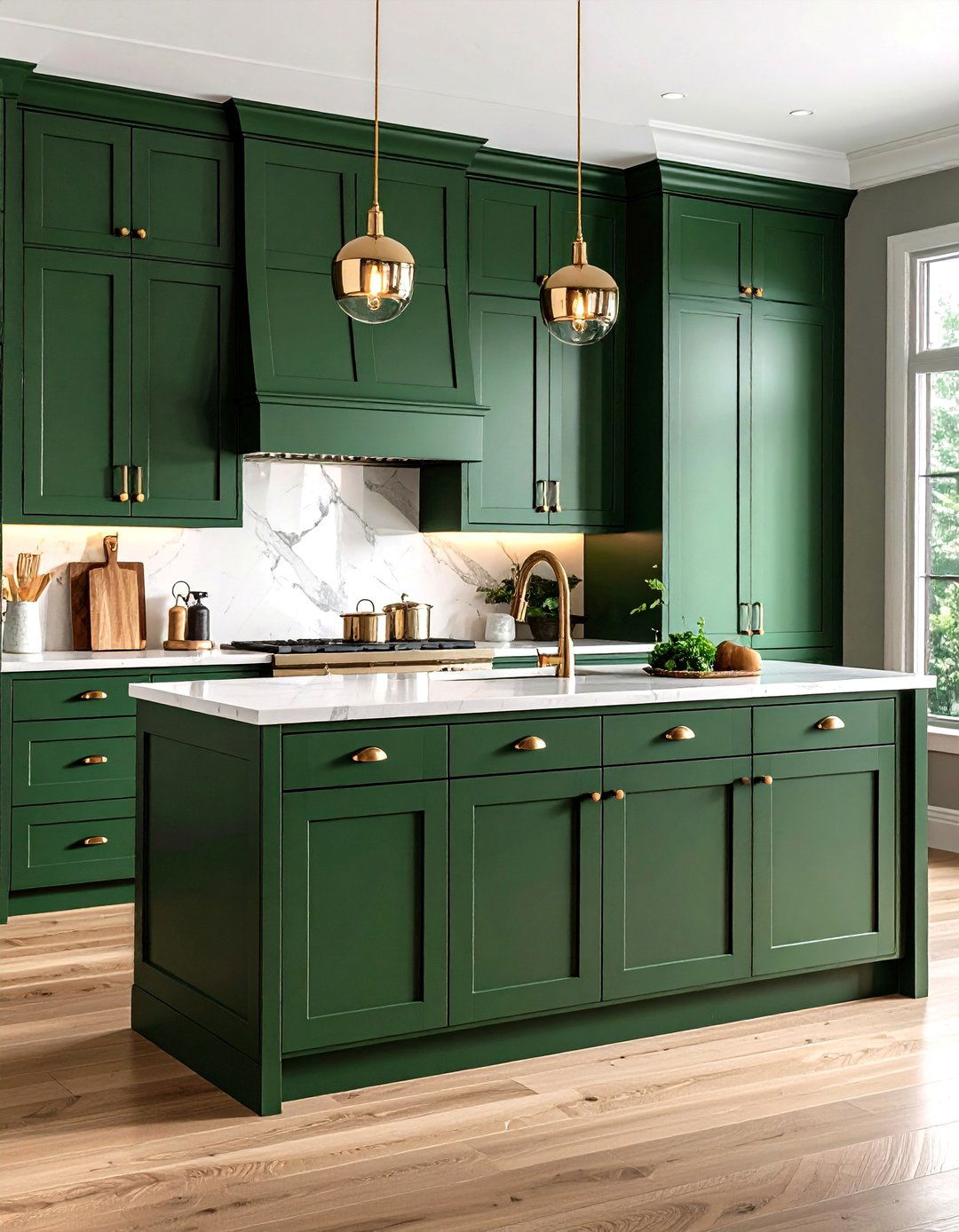
A dramatic sweep of forest green across every cabinet instantly wraps the kitchen in a woodland calm, and trend reports show the hue poised to eclipse yesterday’s navy or sage. Opt for brushed-oak doors so subtle grain shows through the paint and adds depth without fuss. Satin-brass pulls warm the cool undertone, while interior LEDs keep cupboards from feeling cavernous. Because the color hides minor scuffs, you can choose slimmer shaker rails or flat panels for a sharper silhouette. Finish with low-sheen varnish—gloss can feel dated—and your countertop becomes the sole contrasting plane, turning everyday prep into a gallery-like vignette.
2. Forest Green Island as a Confident Statement Piece
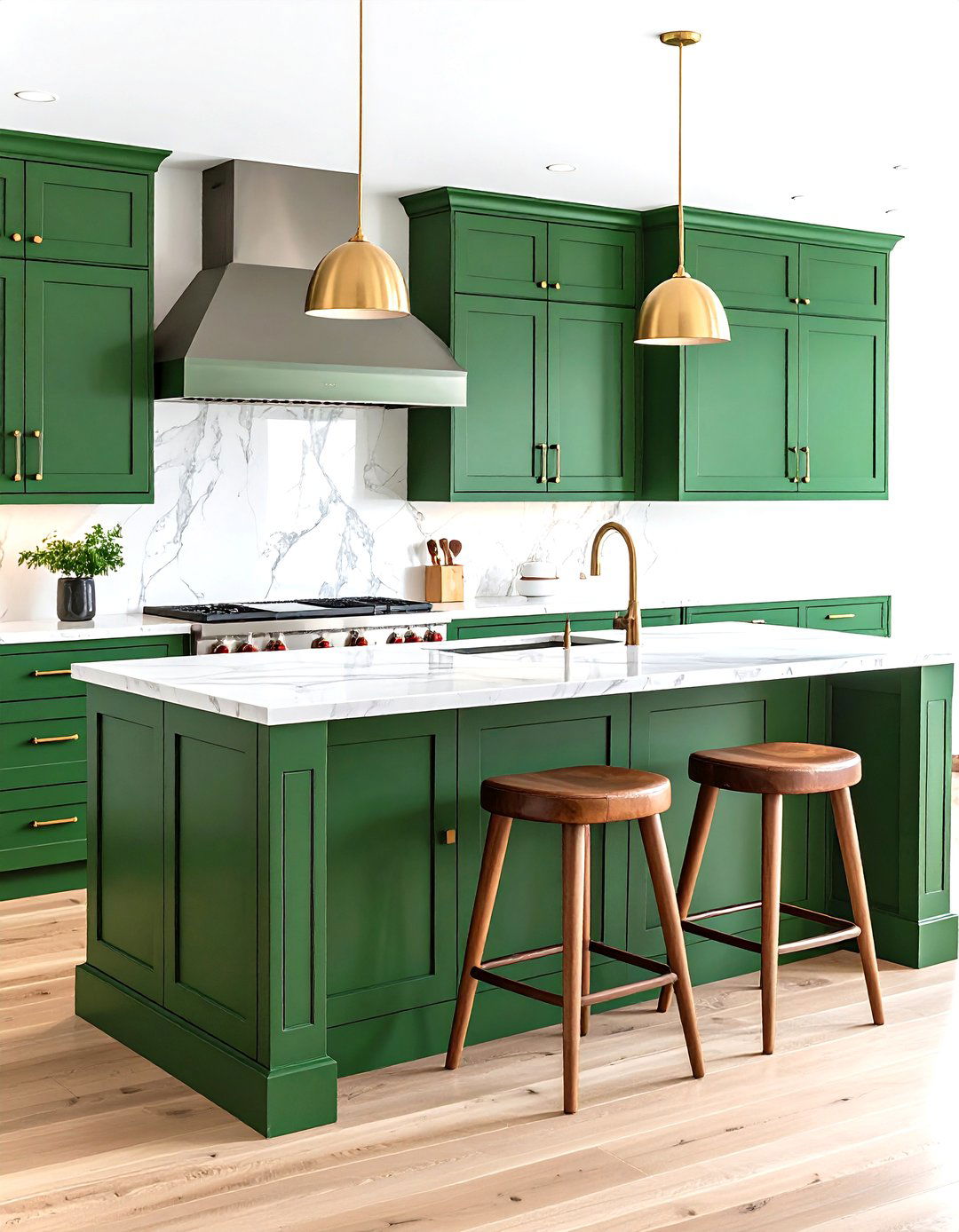
Take the island only, drench it in forest green, and let the surrounding cabinetry stay neutral. A recent remodel proves that even a small pop of saturated color makes stools, pendant lights, and vintage runners appear curated rather than cluttered. Tie the look together with matching toe-kicks or a painted range hood strap, so the accent feels intentional. If you entertain, extend the paint behind bar seating to create a convivial zone that hides shoe marks. For extra resilience, specify a scuff-resistant enamel and top it with veined marble—cool white stone amplifies the depth of the green while doubling as a photogenic pastry surface.
3. Forest Green & Crisp White Countertops for Instant Contrast
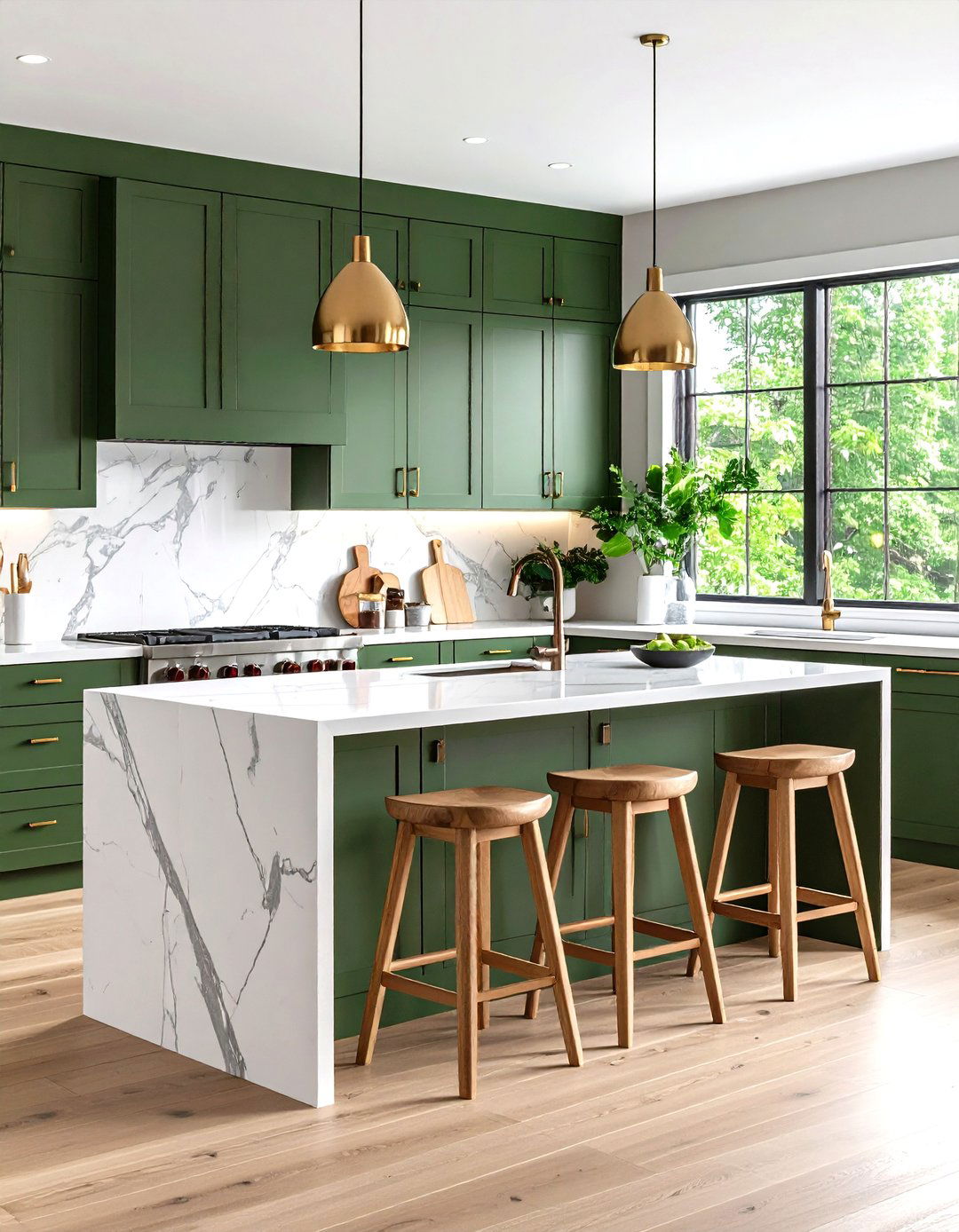
Unlike monochrome schemes, the pairing of deep forest green cabinets with bright white quartz or porcelain slabs delivers a zingy, modern contrast that still feels classic. The unbroken light surface bounces daylight back onto dark doors, keeping the room airy even in winter. Choose a countertop with faint gray veining to echo stainless appliances and soften the divide. Waterfall edges on an island sharpen the look further, while a micro-beveled white backsplash reduces grout lines for quick wipe-downs. Add white oak bar stools to bridge the palette and you gain a subtle Scandinavian twist without repainting a thing.
4. Forest Green Cabinets with Lustrous Brass Hardware
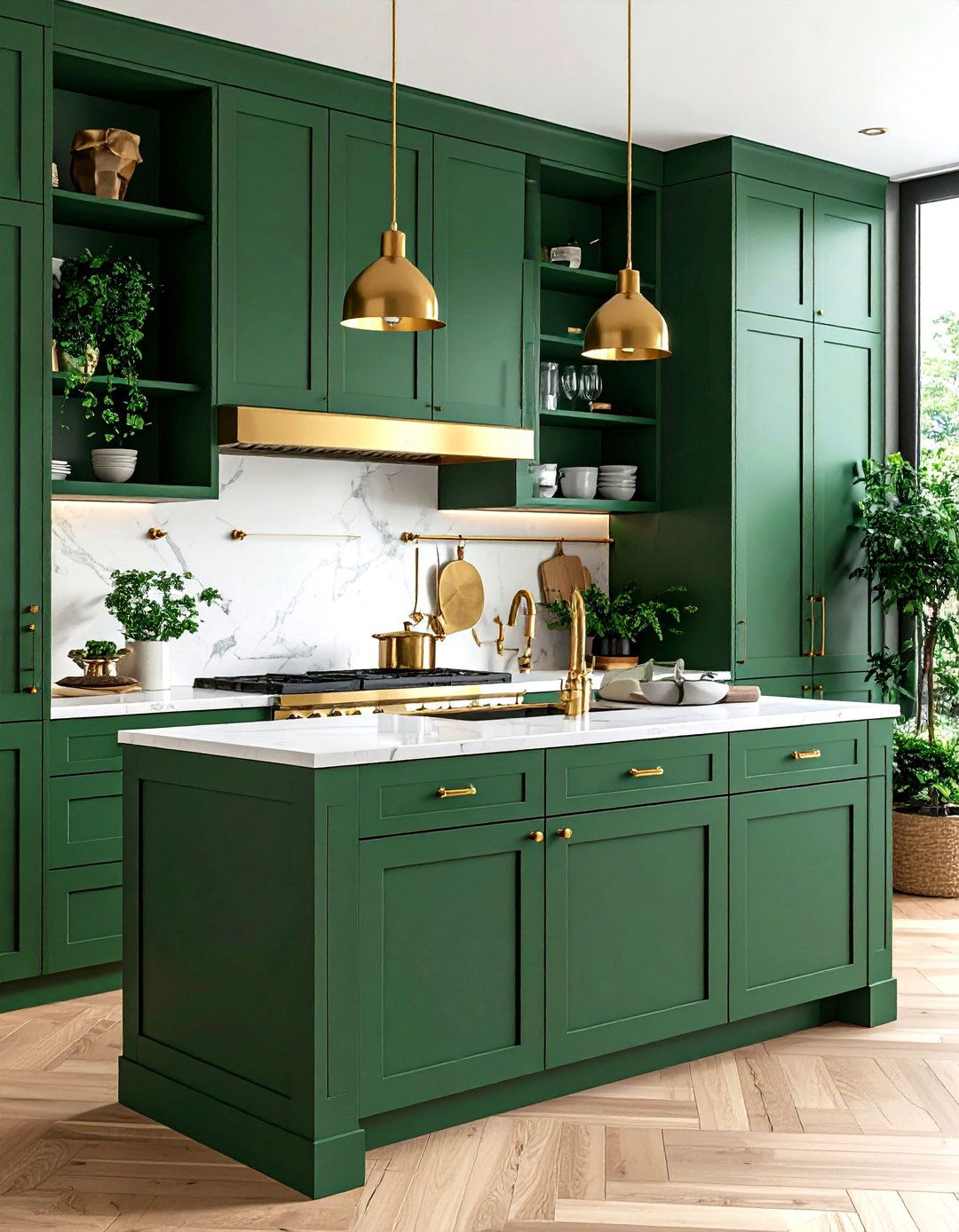
For hardware, polished chrome can feel icy against green, but brushed or unlacquered brass injects warmth and patina that grows richer over time. Designers repeatedly combine the two for a look that feels both “dressed” and lived-in. Stick to slim pulls and hidden hinges on slab drawers to keep the metal from overpowering the paint. If your budget only stretches to knobs, try mixing round knobs on uppers with linear pulls on base units; the variation introduces craft-level detail without a custom millwork fee. Swap in brass-framed open shelves above the range to echo the finish and break up long runs of solid doors.
5. Layer Forest Green with Warm Wood Shelving
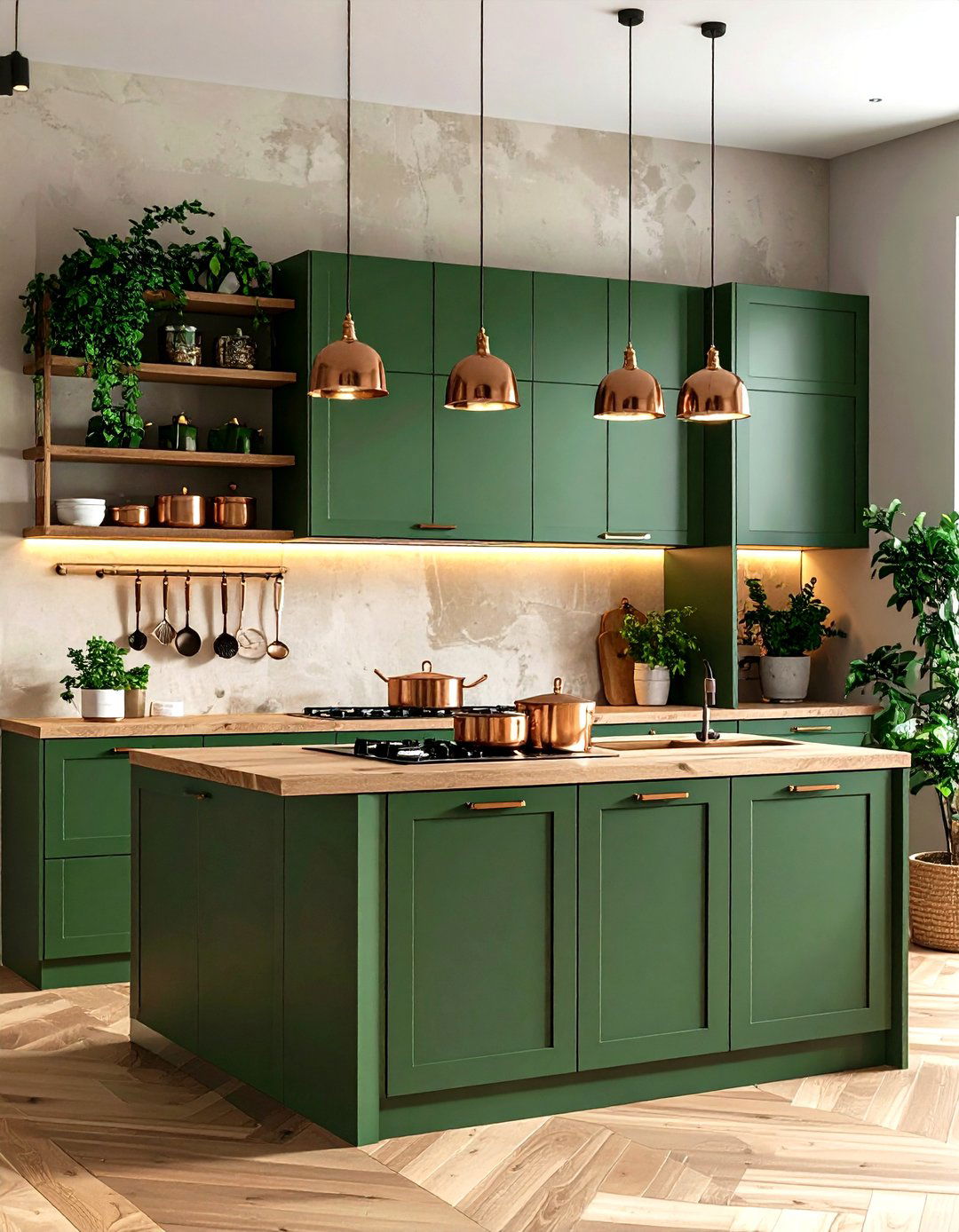
Looking for organic warmth? Floating shelves in walnut or white oak soften the depth of forest green cabinets while providing quick-grab storage for daily dishes. The natural grain subtly repeats the shade’s earthy roots and lets you showcase textured ceramics or copper cookware. Stain shelves several tones lighter than the green so the eye registers contrast, and use concealed brackets so the wood seems to hover. Under-shelf LED strips spotlight collections at night and double as task lighting. Finish the wall with lime-washed plaster or oversized subway tile for tactile interest that doesn’t fight the palette.
6. Subway and Zellige Tiles in Coordinated Greens
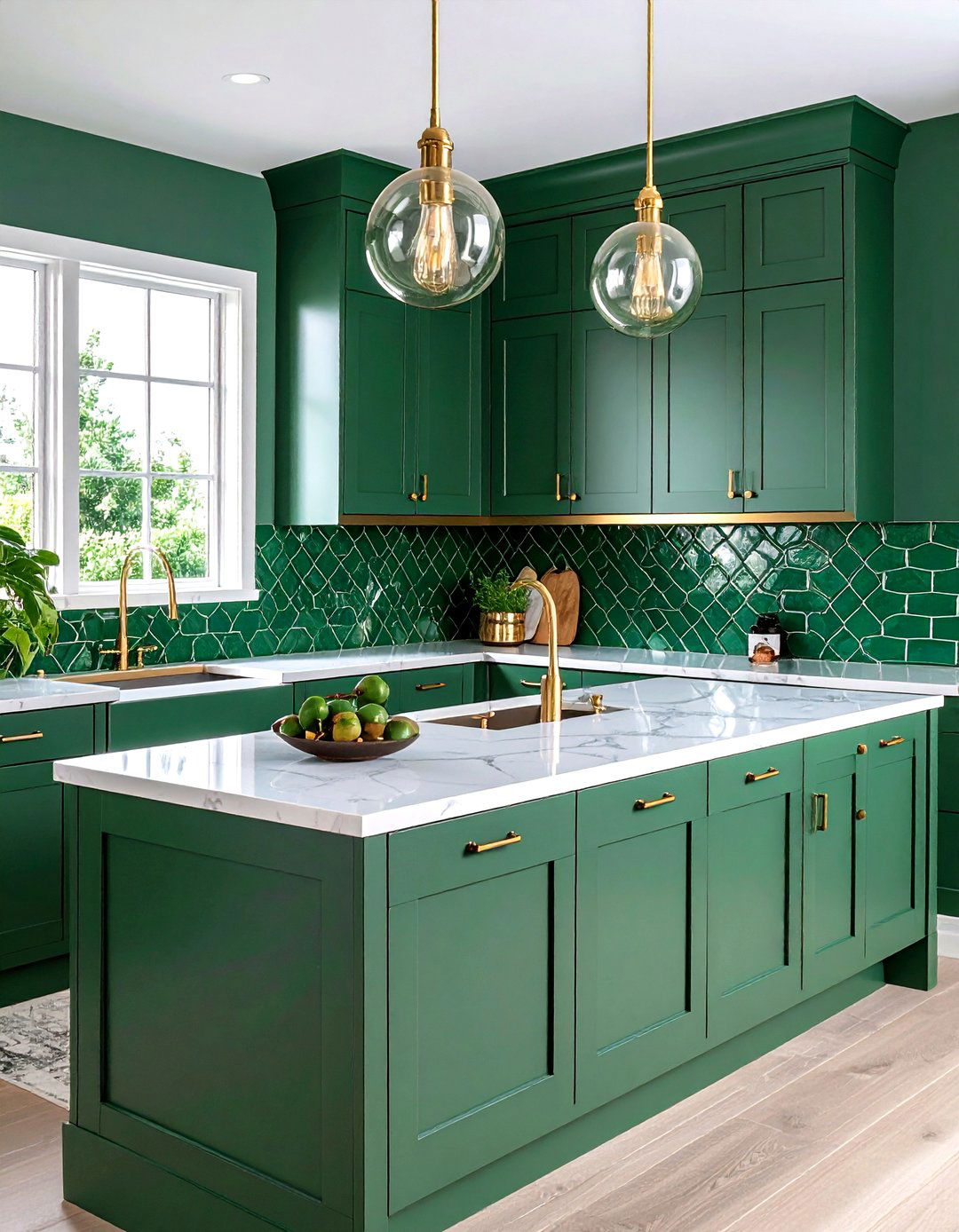
With backsplash tile, subtle shade variation beats a perfect match. Hand-pressed zellige or artisan subway pieces in complementary greens introduce a watery shimmer that makes cabinets feel bespoke. Keep grout narrow and tone-on-tone so the field reads as color, not pattern. For extra depth, lay tiles vertically behind the range and horizontally elsewhere; the layout shift frames the cooker like art. Finish edges with brass schluter to echo hardware and seal porous clay tiles with breathable wax so splatters wipe away. The irregular glaze means every backsplash is unique, even in a cookie-cutter footprint.
7. Marble Veins Elevate a Forest Green Palette
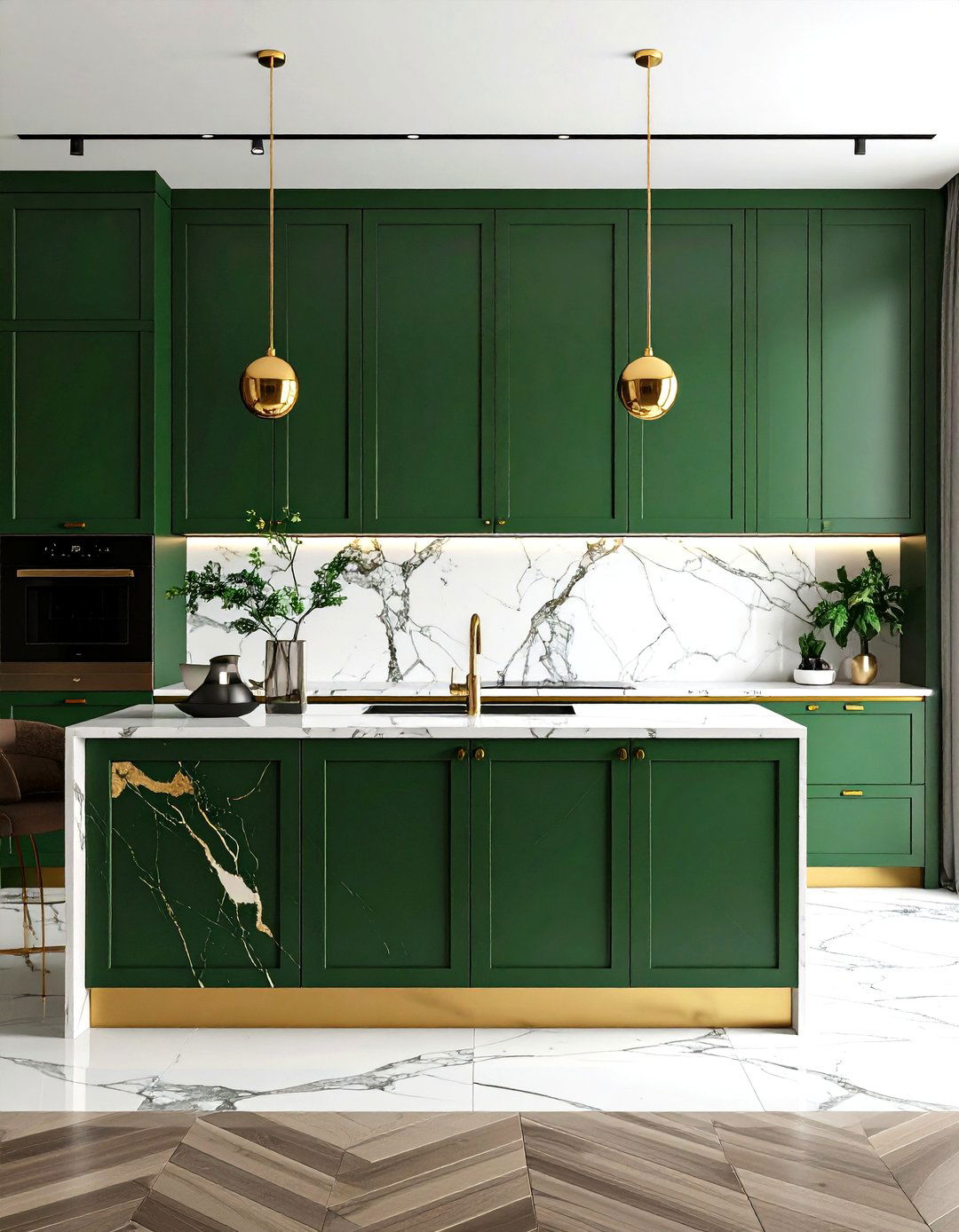
Rich, forest-green fronts become downright luxurious when topped with heavily veined marble—designers often cite calacatta or panda varieties for their dramatic black-and-gold ribbons. The pattern breaks up large planes of color while the stone’s cool undertone reins in the cabinet’s warmth. Run the slab six inches up the wall instead of a traditional 4-inch lip to protect paint and create a sleek ledge for salts or a slim phone stand. If you cook often, specify honed or leathered finishes; they disguise etching and feel velvety against glassware.
8. Smart Forest Green Solutions for Compact Kitchens
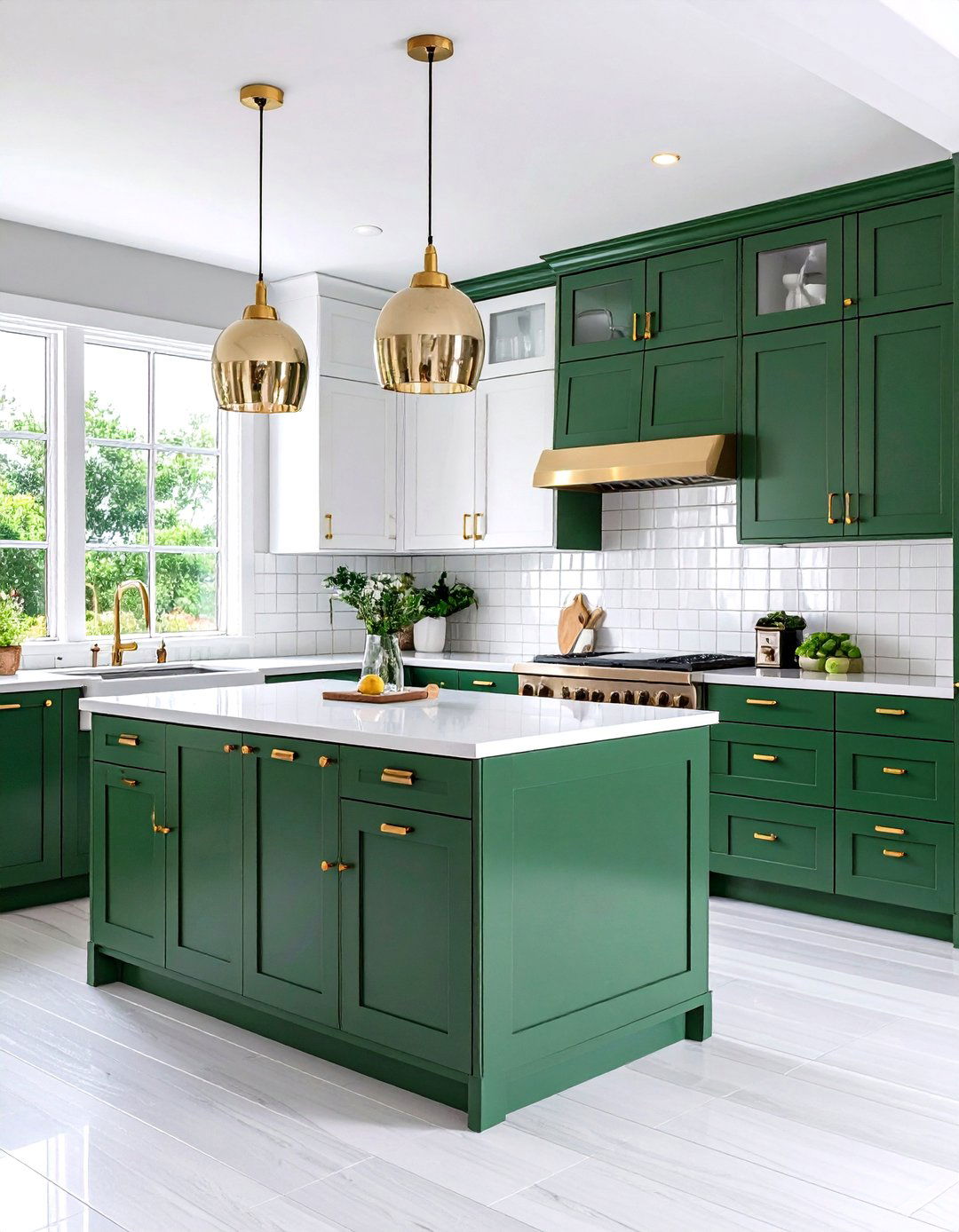
Shortly after moving into a studio, one renter painted only the lower cabinets forest green, visually anchoring the space without shrinking it. Install reflective glazed-tile backsplashes and glossy upper doors so light bounces around and keeps the room bright. Choosing integrated pulls instead of protruding handles avoids hip bumps, and painting tall pantry doors the same green elongates the wall, making ceilings appear higher. Opt for multipurpose furniture—like a rolling butcher-block cart—in a matching tone to double as island and dining perch. A limiting footprint becomes an intentional jewel-box when every inch shares the same confident hue.
9. Two-Tone Layout: Forest Green Lowers, Light Uppers

For those who fear too much darkness, limit forest green to base cabinets and ground the look with crisp white, cream, or pale-wood uppers. The lighter top visually recedes, creating breathing room around wall cabinets, while the saturated base hides scuffs from daily meal prep. Balance the transition with a horizontally laid backsplash so the eye glides between zones. Edge-mount under-cabinet lighting beneath the light uppers to splash brightness onto green doors, and consider painting window frames the cabinet color to tie levels together. This split palette feels airy but still daring.
10. Forest Green Meets Matte Black Accents

Despite common fears, dark on dark can feel luxe rather than gloomy when balanced well. Today’s “moody kitchen” trend pairs forest green cabinets with matte-black faucets, range hoods, and even appliances for a cocoon-like vibe that still reads sophisticated. Break potential monotony by selecting hardware with textural knurling and adding ribbed-glass doors to show glints of china. Keep countertops pale or add a skylight if natural light is scarce—the black recedes, letting the green claim center stage. The palette photographs beautifully, making it ideal for avid cooks who share creations online.
11. Illuminate Forest Green with Gold & Glass Lighting
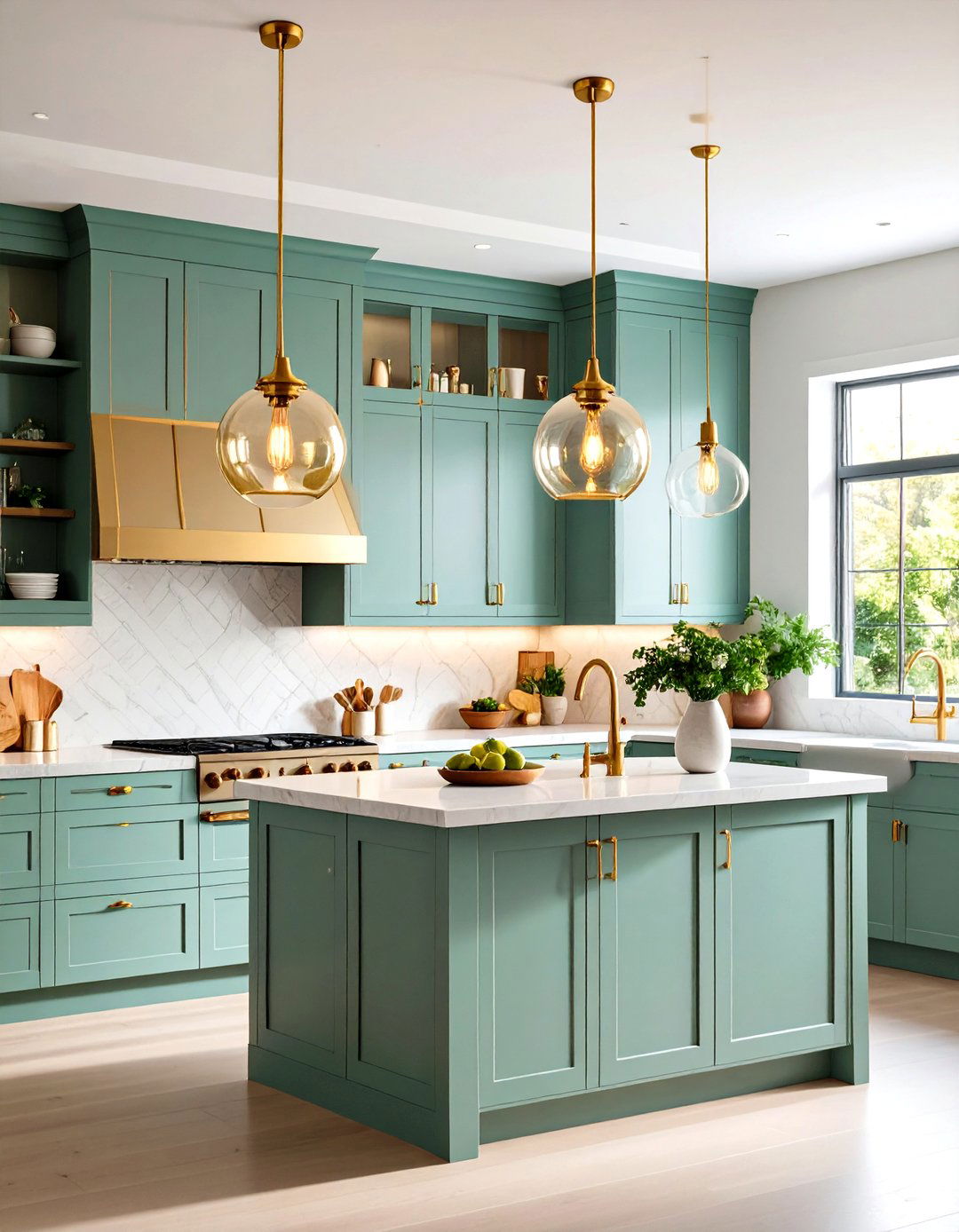
Looking to glam things up? Swap dated pendants for clear-glass globes with gold leaf interiors; the metallic glow heightens the richness of forest green while the transparency maintains sightlines. Complement overhead fixtures with slim gold picture lights above open shelving so favorite cookbooks shine. Choose dim-to-warm bulbs that shift from task-bright to supper-soft, echoing candlelight against the dark cabinetry. On islands, space pendants no more than 30 inches apart to avoid odd shadows on the green surface. Even a rental benefits from upgraded lighting, because fixtures unscrew when it’s time to move.
12. Classic Shaker Forest Green in English-Style Kitchens
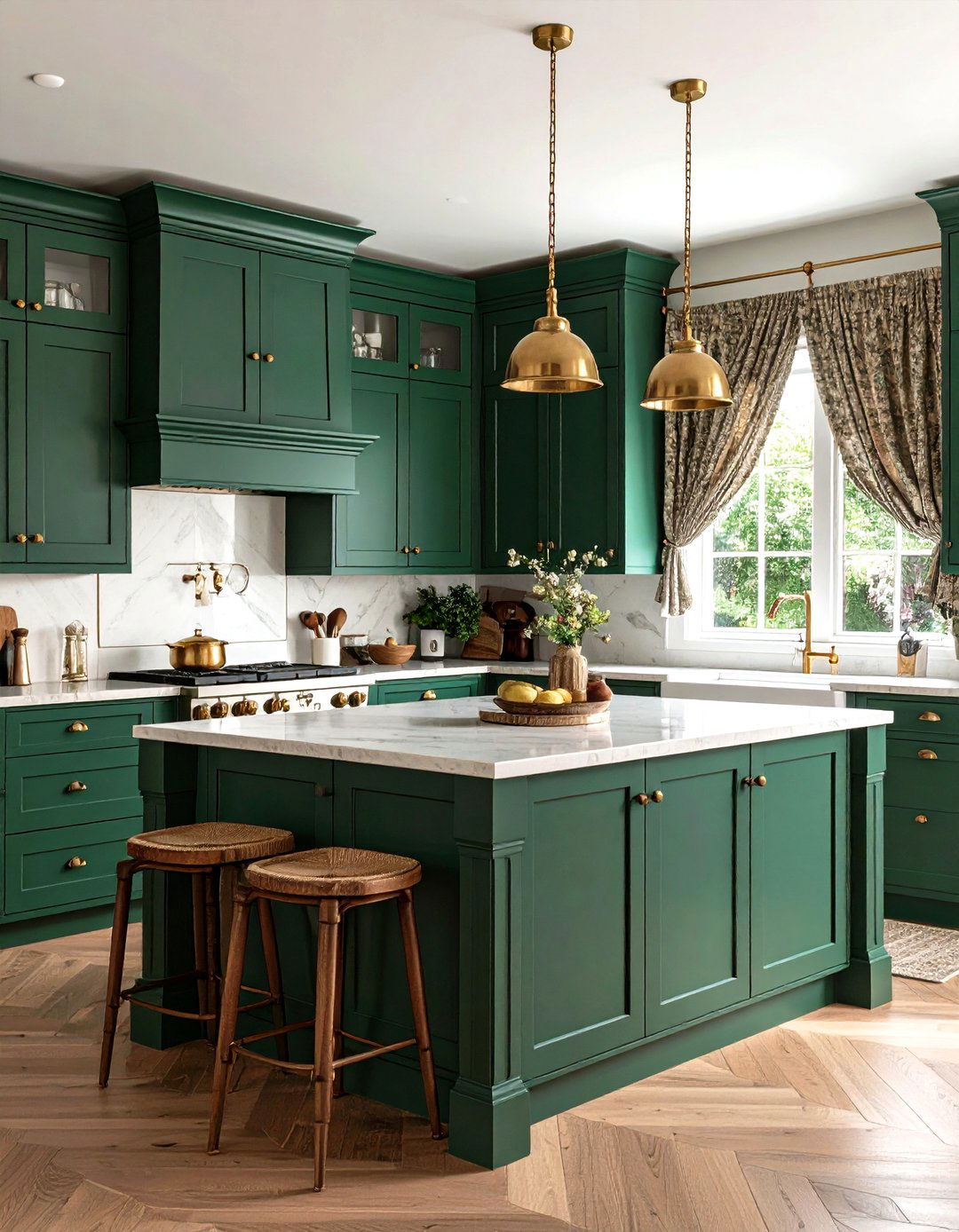
Classic English kitchens are staging a comeback, favoring shaker doors, natural counters, and historical color palettes—forest green chief among them. Install cup pulls, tongue-and-groove end panels, and a free-standing hutch in the same shade for authentic character. For countertops, choose unpolished soapstone; its charcoal base highlights green cabinetry while feeling softer than granite under forearms. Hang pleated fabric café curtains on brass rods instead of blinds to introduce pattern. The result balances nostalgia with 21st-century functionality, creating a heart-of-the-home vibe perfect for lingering Sunday roasts.
13. Pick the Perfect Forest Green Paint without Regret
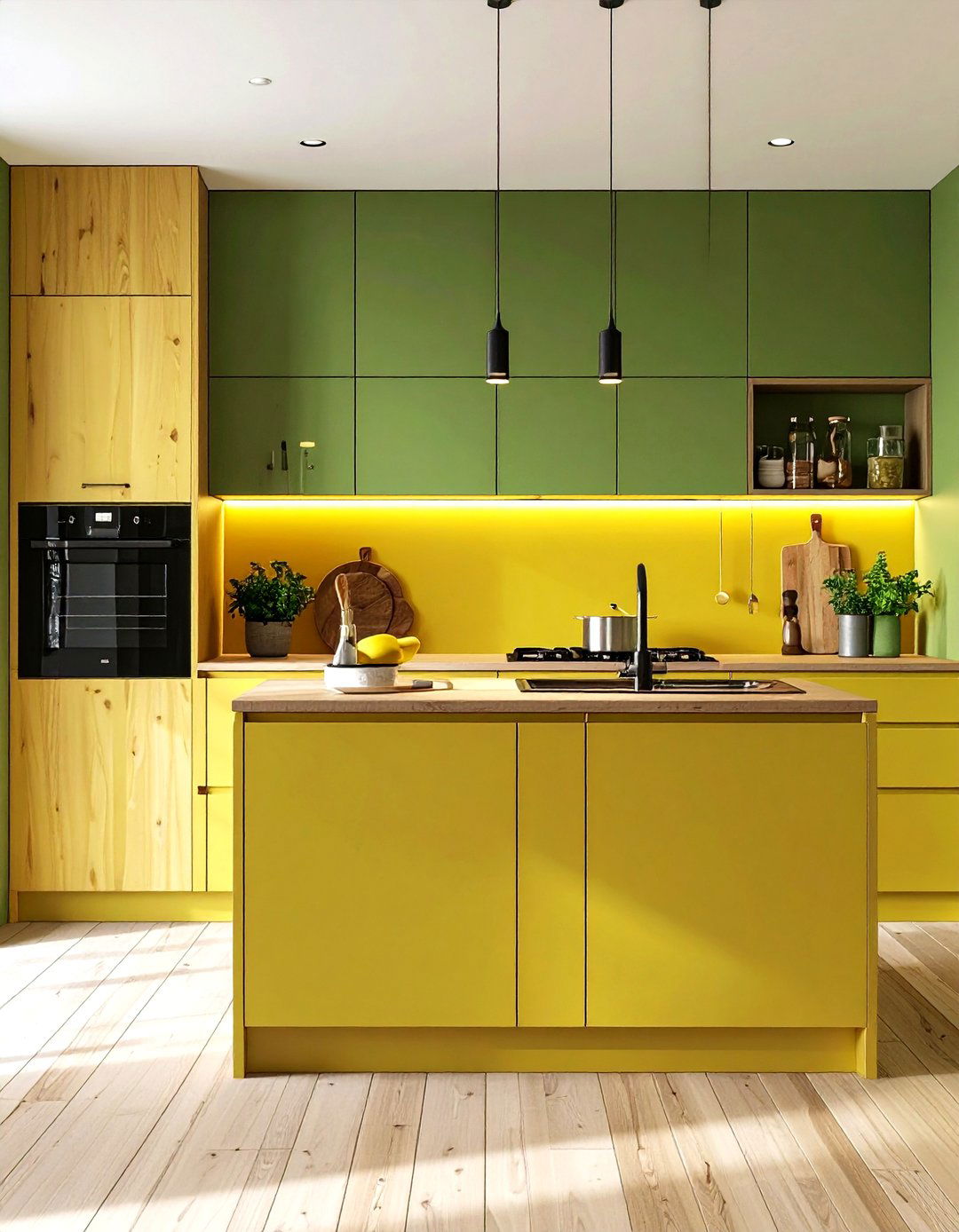
Selecting paint can overwhelm, but pros often point to mid-tone greens that shift from almost-black at night to verdant by day. One trusted formula, a shade called “Forestwood,” offers excellent coverage and a 4 on the light-reflectance scale—dark enough for drama, yet not jet. Always sample on two walls and watch how under-cabinet LEDs alter perception. If your space leans north-facing (cool light), choose a green with a hint of yellow to prevent grayness; south-facing rooms can handle bluer undertones. Top everything with washable, low-sheen enamel so spaghetti splatters wipe away without ghost marks.
14. Terrazzo Floors Under a Forest Green Canvas
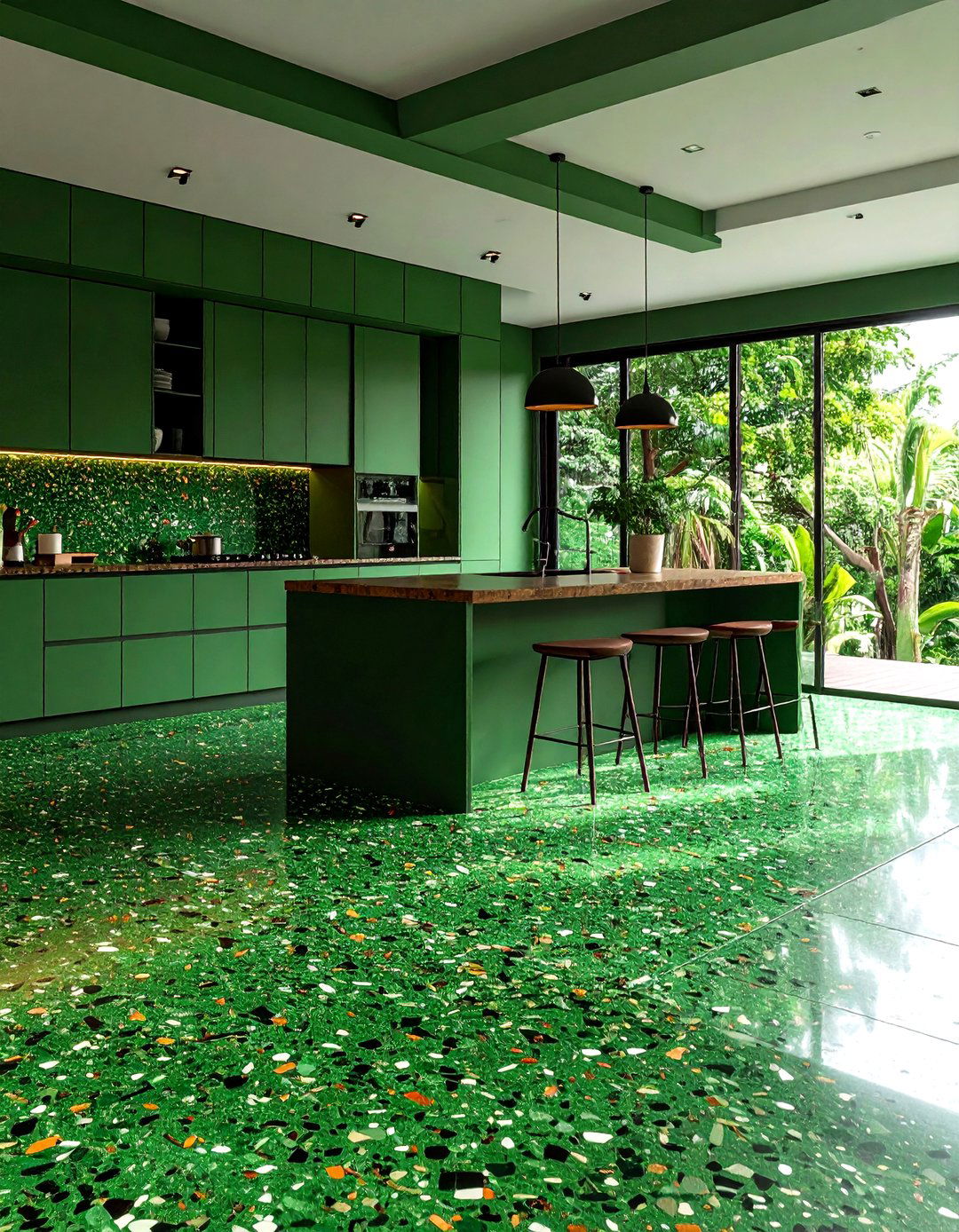
Surprisingly, the playful speckle of terrazzo tiles tempers the seriousness of dark cabinetry, adding movement underfoot. Designers mix forest green with terrazzo chips that echo cabinet, hardware, and countertop colors for cohesion. Choose large-format slabs to reduce grout and seal with matte finish for slip resistance. Because terrazzo is poured or set thin, it keeps floor thickness down—handy for retrofits where height is limited. The composite also resists scratches, making it kinder to pets’ claws than softer woods. A green-toned floor border around the island further frames the working zone like an inlaid rug.
15. Forest Green Breakfast Nook or Pantry Alcove
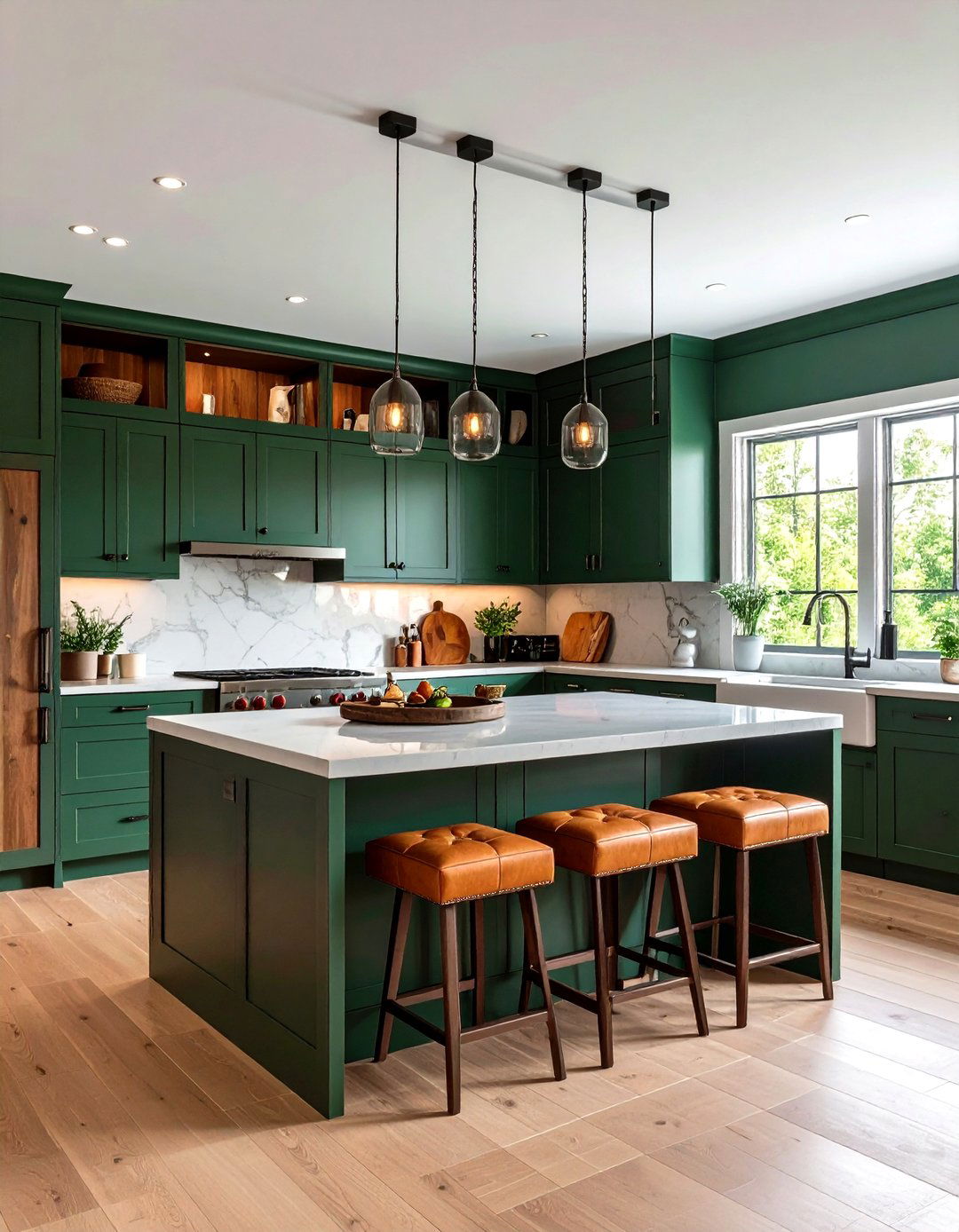
Rather than painting every surface, concentrate forest green in a built-in pantry or banquette nook to spotlight the architecture. Enclose storage with floor-to-ceiling doors, use discreet touch latches, and line interiors with cedar or patterned wallpaper for a pleasing surprise. For a cozy dining niche, upholster bench cushions in cognac leather and add adjustable sconces for ambient reading light. This color-blocked approach zones the kitchen, helping open-plan spaces feel layered. If walls elsewhere stay white, the green alcove reads like a stylish piece of furniture rather than a structural add-on.
16. Mix Forest Green with Glass-Front Showcases

Glass-front cabinets painted inside and out in the same forest green create a jewel-box display for crystal, vintage china, or even cookbooks. Frosted or reeded glass blurs everyday mismatched mugs while preserving light flow. Internally, line backs with beadboard painted one shade lighter to deepen dimension. Install micro-LED puck lights on motion sensors so cabinets glow when opened—practical for late-night snacking. Finish frames with slim, unlacquered-brass edge beading for a furniture-like finish that elevates stock cabinetry into heirloom territory.
17. Extend Forest Green to the Ceiling for Cozy Drama
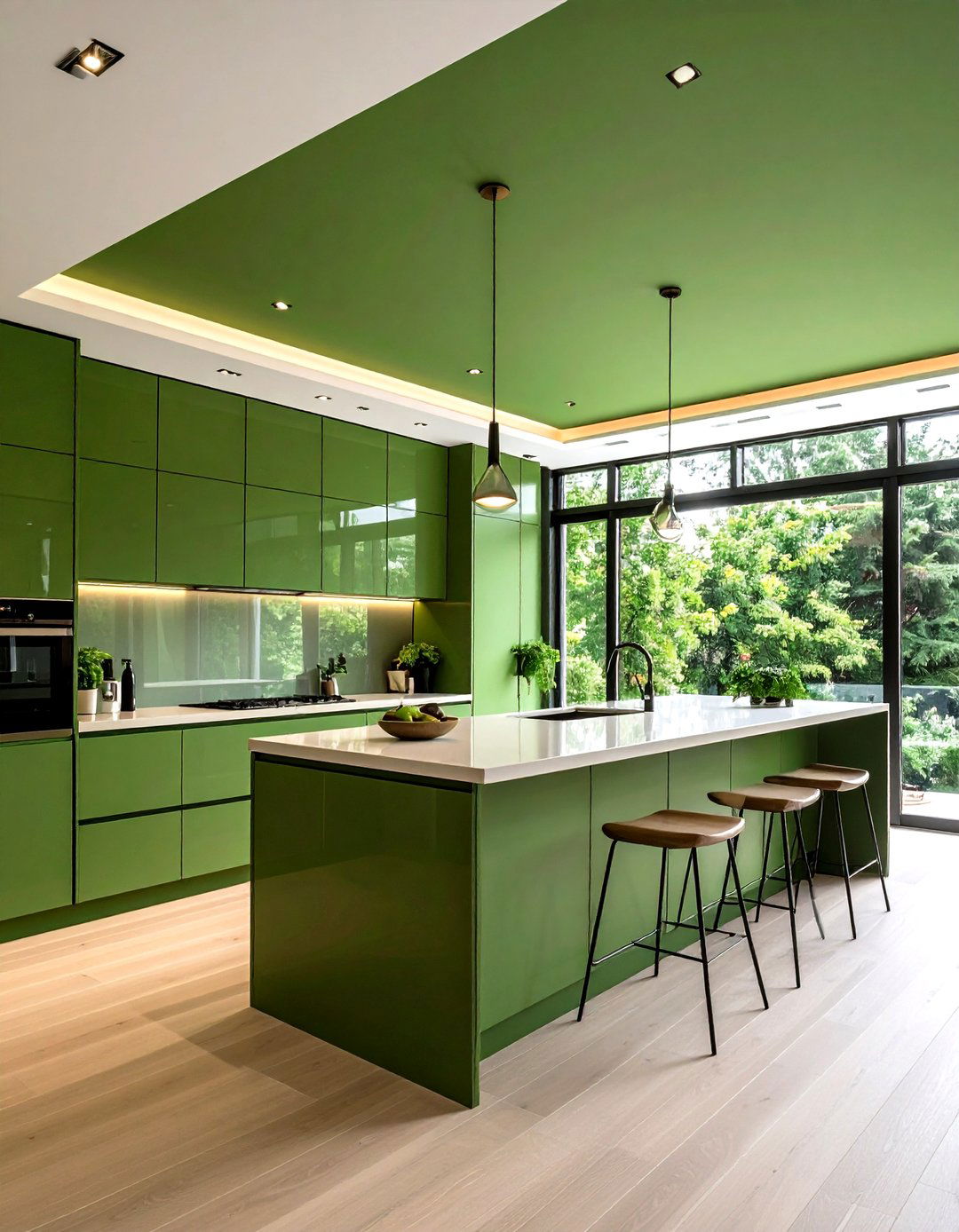
Although unconventional, carrying forest green onto the ceiling shortens overly tall rooms and amps up intimacy, echoing the “moody kitchen” direction many pros champion. To avoid darkness, balance with a pale countertop and reflective brass or mirrored backsplash panels. Flat acrylic paint hides roller marks overhead, while a subtle picture-rail molding in the same shade tidies the transition onto blank walls. Because cooking steam rises, choose a scrubbable finish and vent well. The enveloping color rewards evening gatherings, when pendant glow bounces warmly across every surface.
18. Enhance Forest Green with Lush Indoor Plants
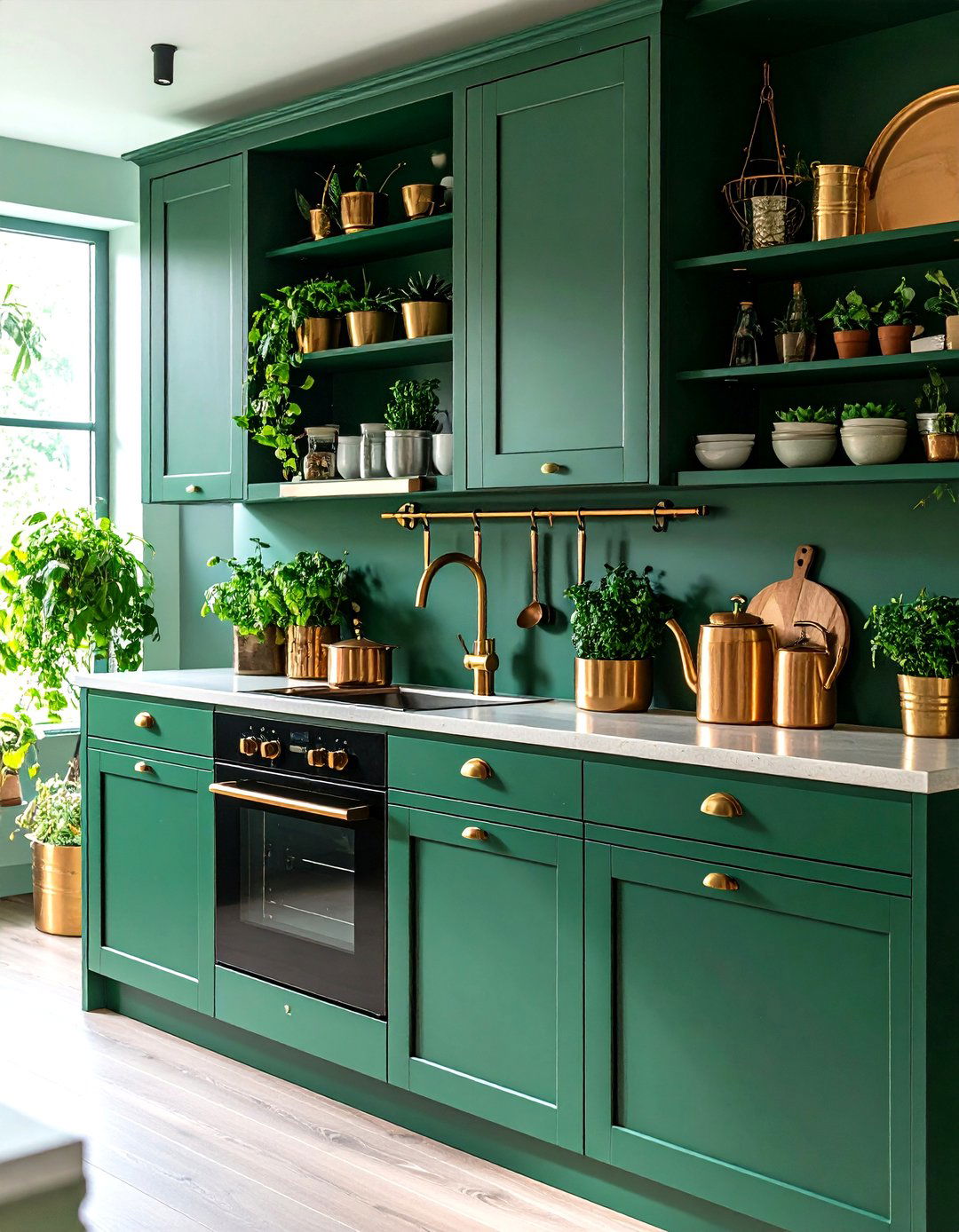
Certainly, nothing accentuates forest green cabinetry like actual foliage. Hanging pothos, countertop herbs, or a potted fiddle-leaf echo the palette and purify air. Position plants near windows but away from intense stove heat. Sleek, brass-lined planters integrate with hardware, and a wall-mounted rail can keep herbs handy for cooking. Even a small ledge above the sink provides enough space for a row of succulents, softening hard surfaces and linking the kitchen visually to garden views beyond the glass.
19. Add Character with Vintage Rugs Against Forest Green Floors
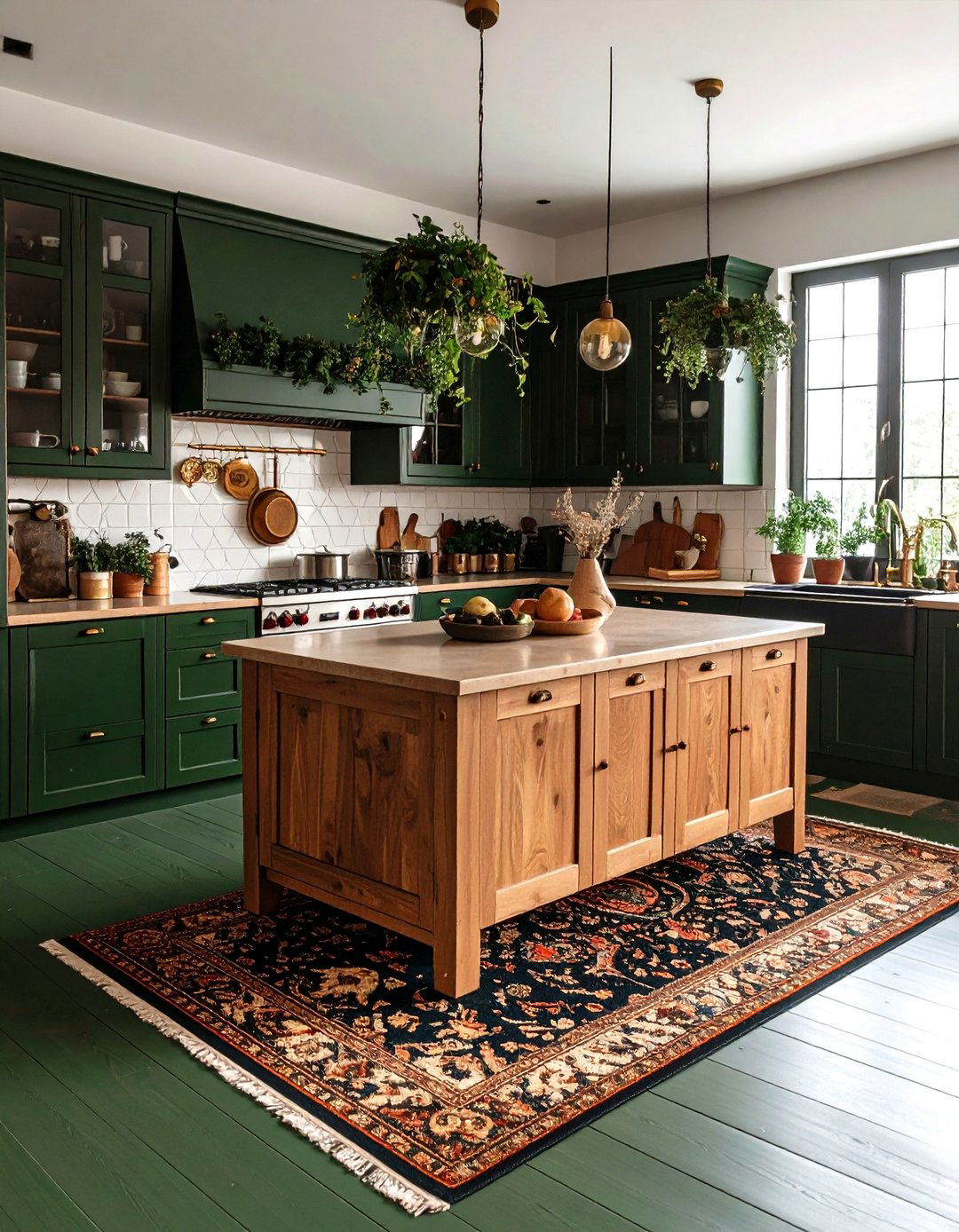
Layering a time-worn Persian or kilim runner over wood or tile introduces pattern and warmth, making forest green cabinetry feel curated rather than showroom-new. Designers often choose rugs with russet, gold, or navy flecks that subtly pick up the cabinet tone. Because kitchens endure spills, look for low-pile wool that repels stains, and secure edges with rug tape to prevent trips. A washable runner works near the sink, while a plusher antique suits the coffee station where drips are fewer. The lived-in textile keeps bold paint from feeling flat, adding soul to sleek remodels.
20. Eco-Forward Forest Green with Sustainable Surfaces
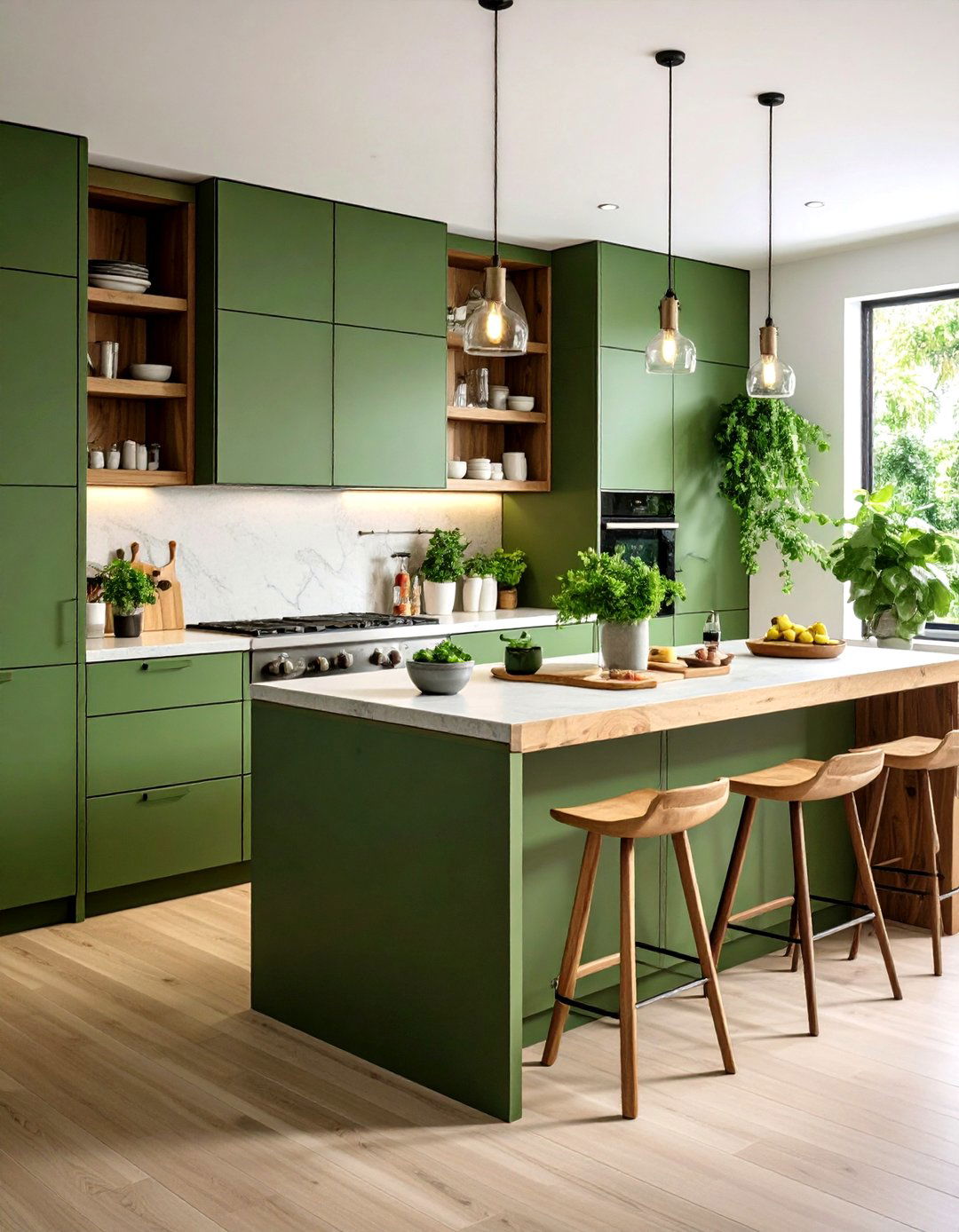
Owing to rising eco-awareness, homeowners are pairing forest green cabinets with recycled-content quartz, reclaimed timber shelves, and energy-efficient appliances to create a kitchen that looks and lives “green.” Low-VOC paints in deep tones now cure as durable as conventional formulas without off-gassing. Stain-resistant hemp or cork flooring undercuts carbon footprints while warming feet. Swap halogen bulbs for tunable LEDs to cut electricity use and enhance the cabinet color’s natural depth. Finally, integrate compost drawers or hidden recycling sorters behind a painted panel to keep sustainability front of mind—proof that style and stewardship can share the same vibrant hue.
Conclusion:
Forest green’s rise from fringe favorite to bona-fide kitchen staple shows that homeowners crave color with depth, versatility, and a touch of drama. Whether you coat every cabinet, spotlight a bold island, or tuck the shade into a cozy nook, the ideas above reveal endless ways to celebrate this evergreen hue with confidence. By balancing rich paint with warm metals, tactile tiles, clever lighting, and sustainable materials, you can craft a space that feels inviting today and timeless for years to come. The forest, it seems, has finally found its perfect home right at the heart of domestic life.


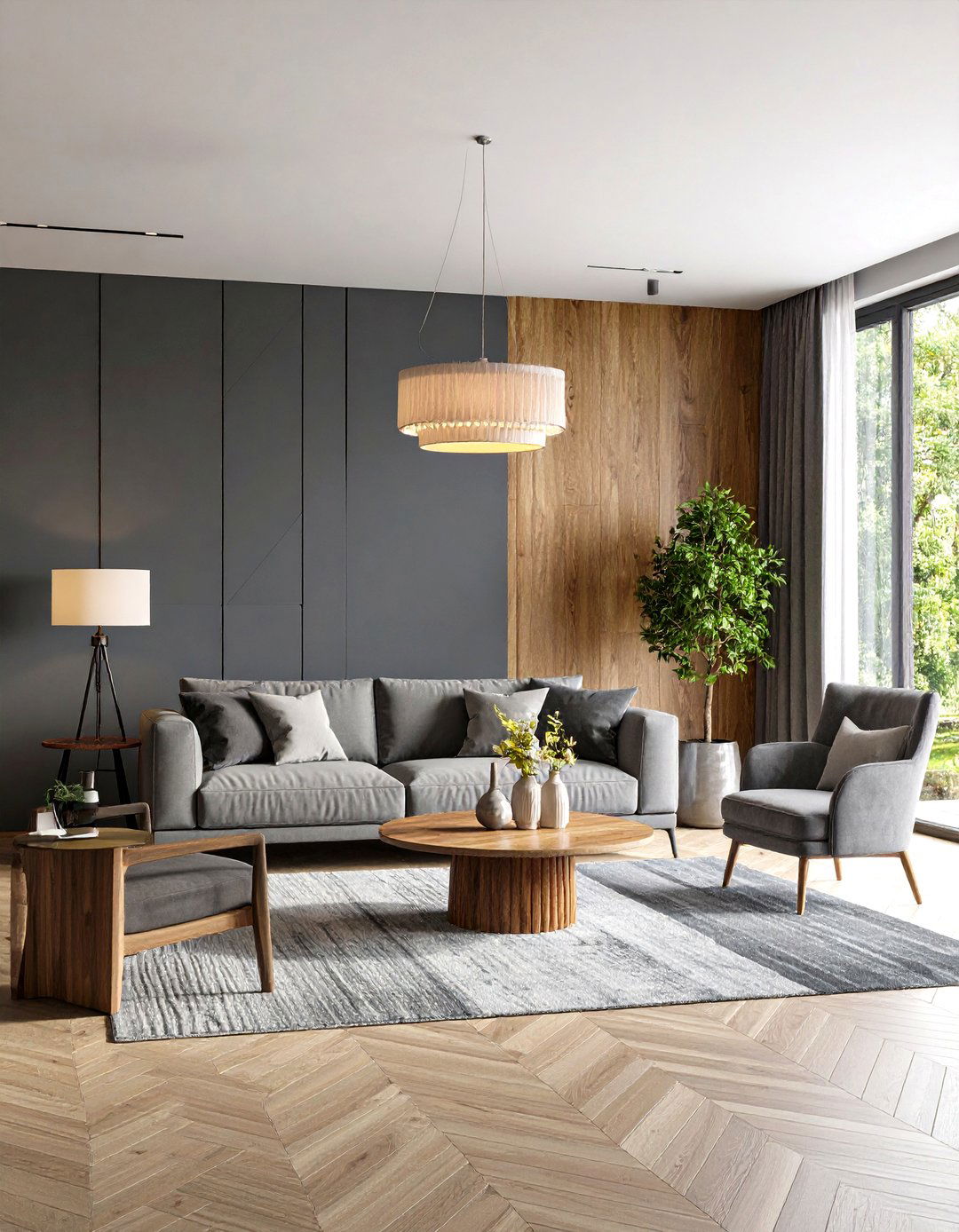


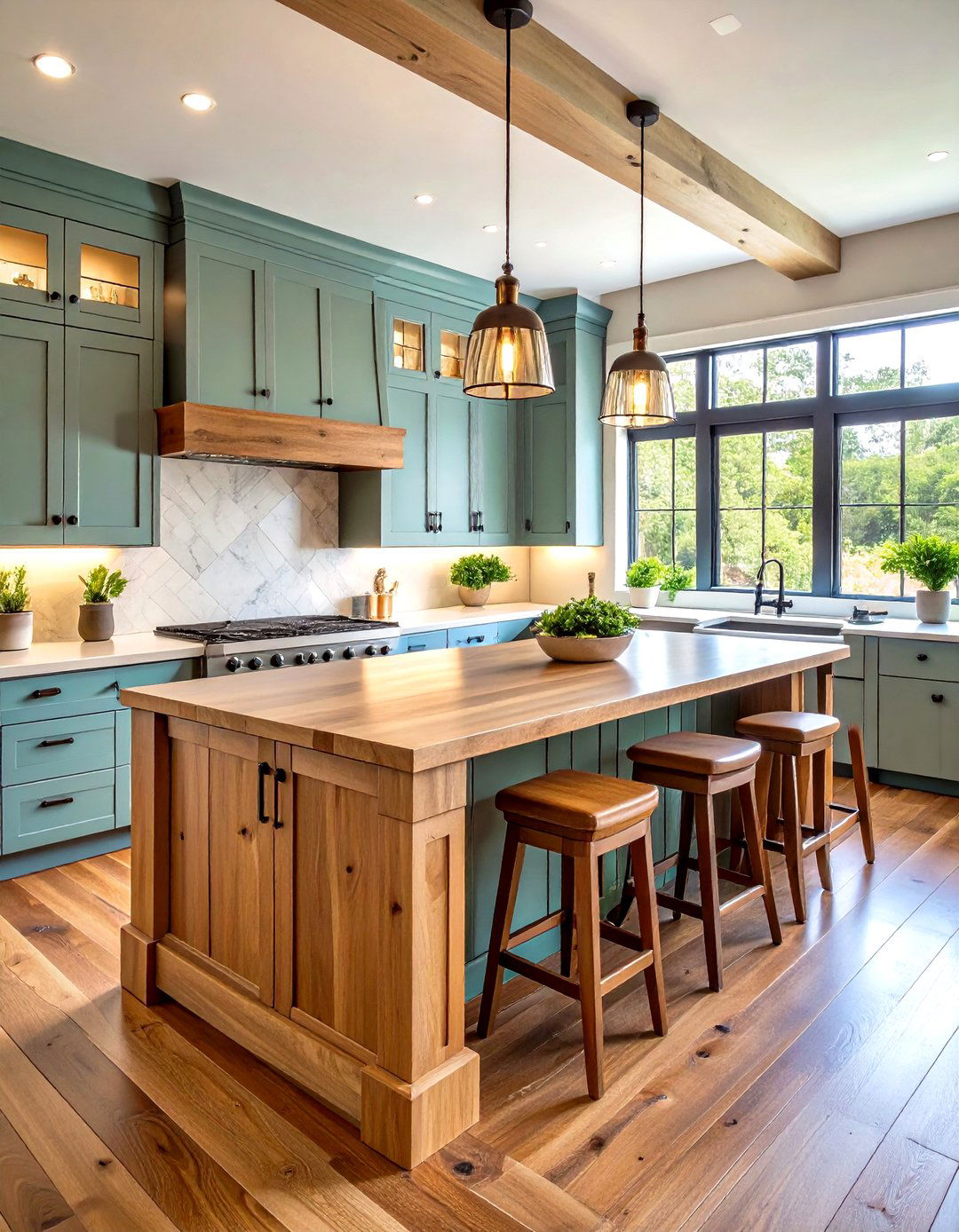
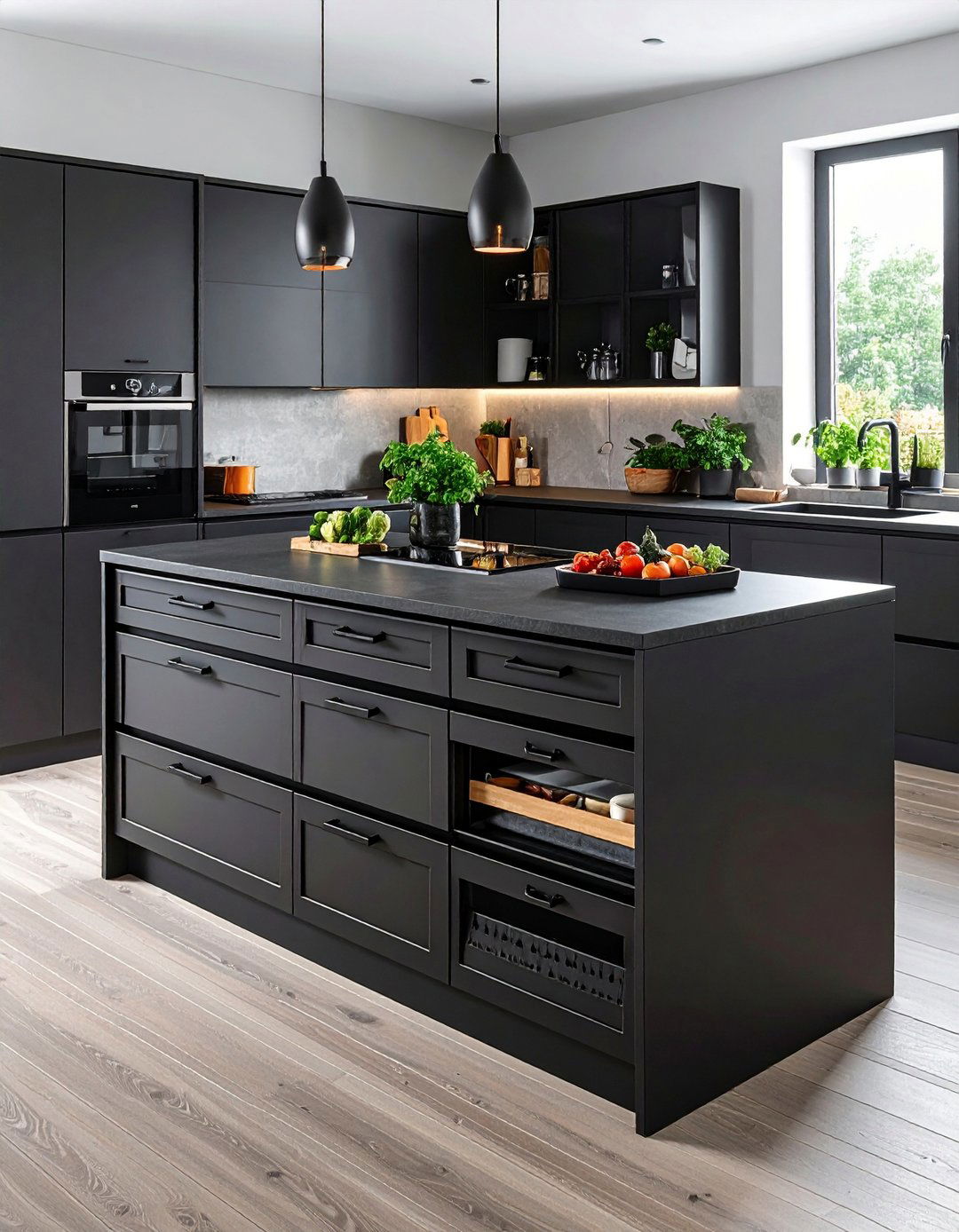


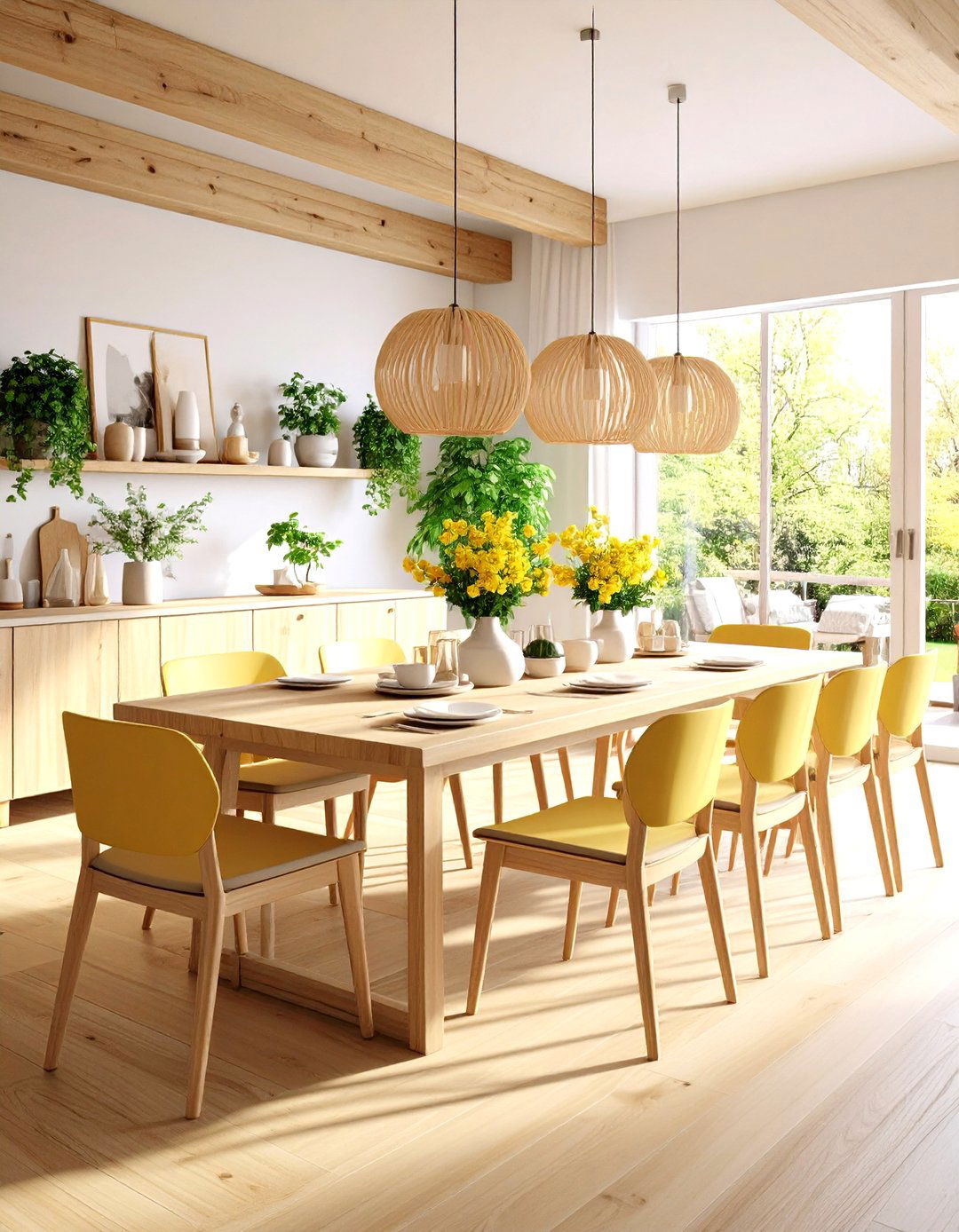
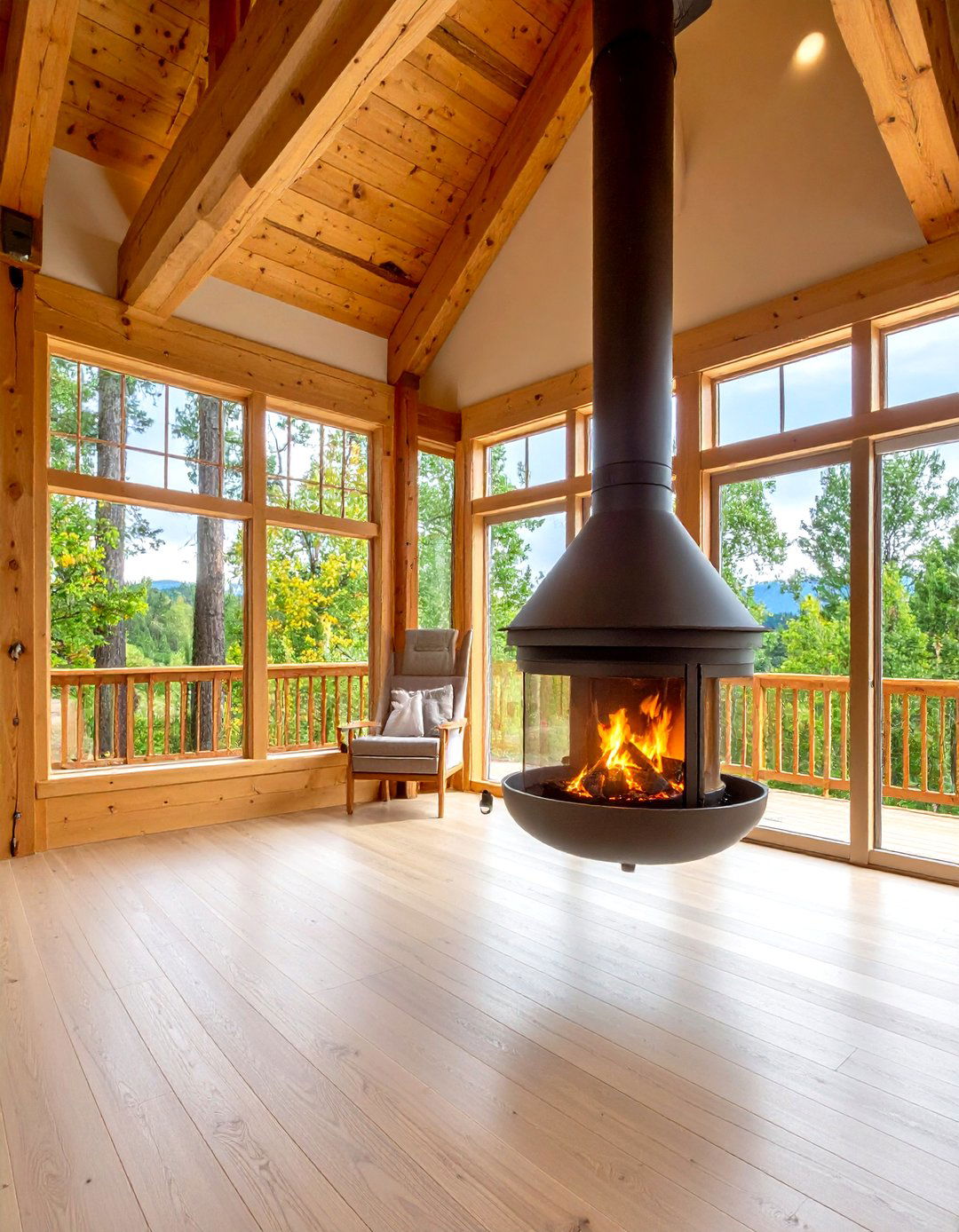
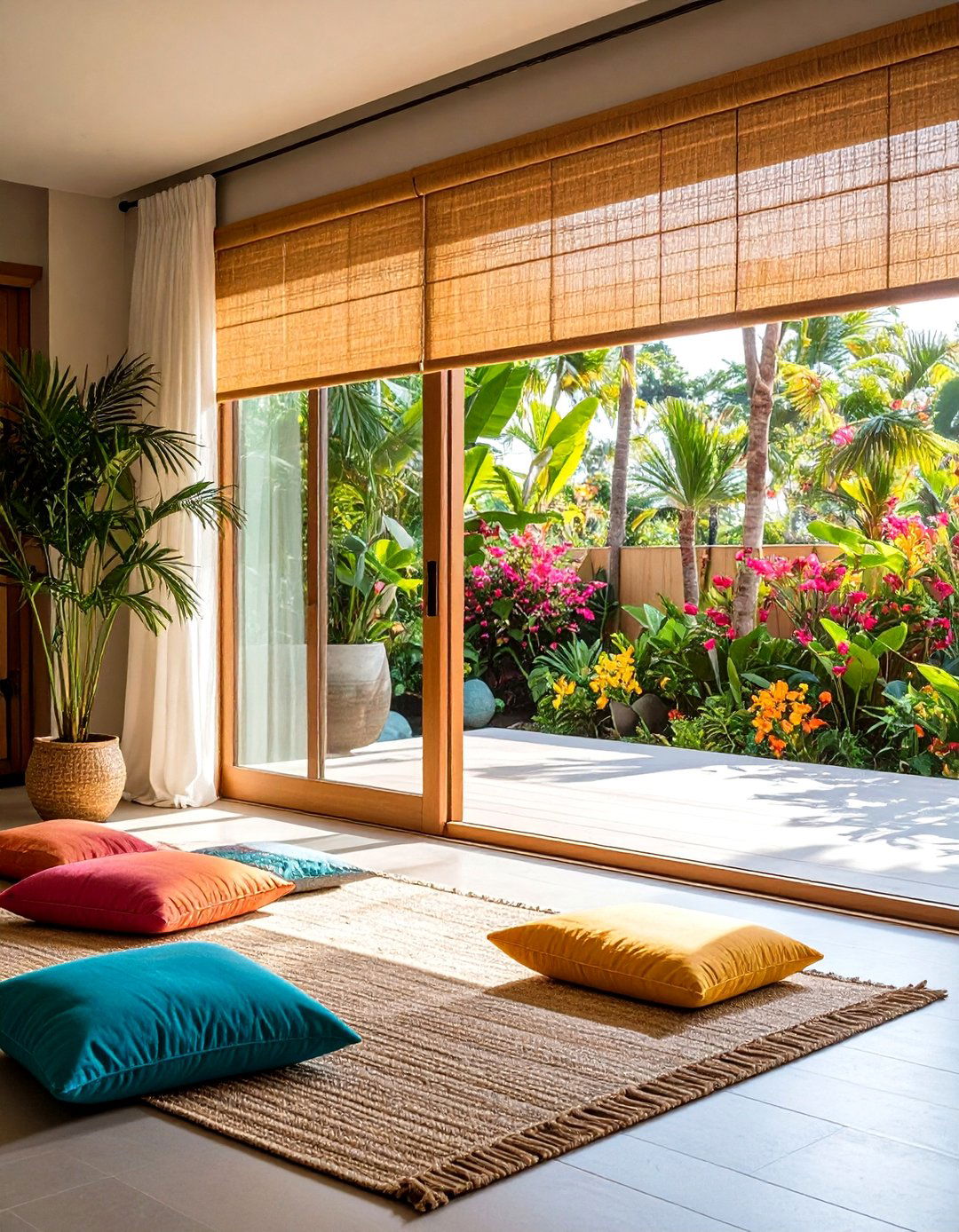
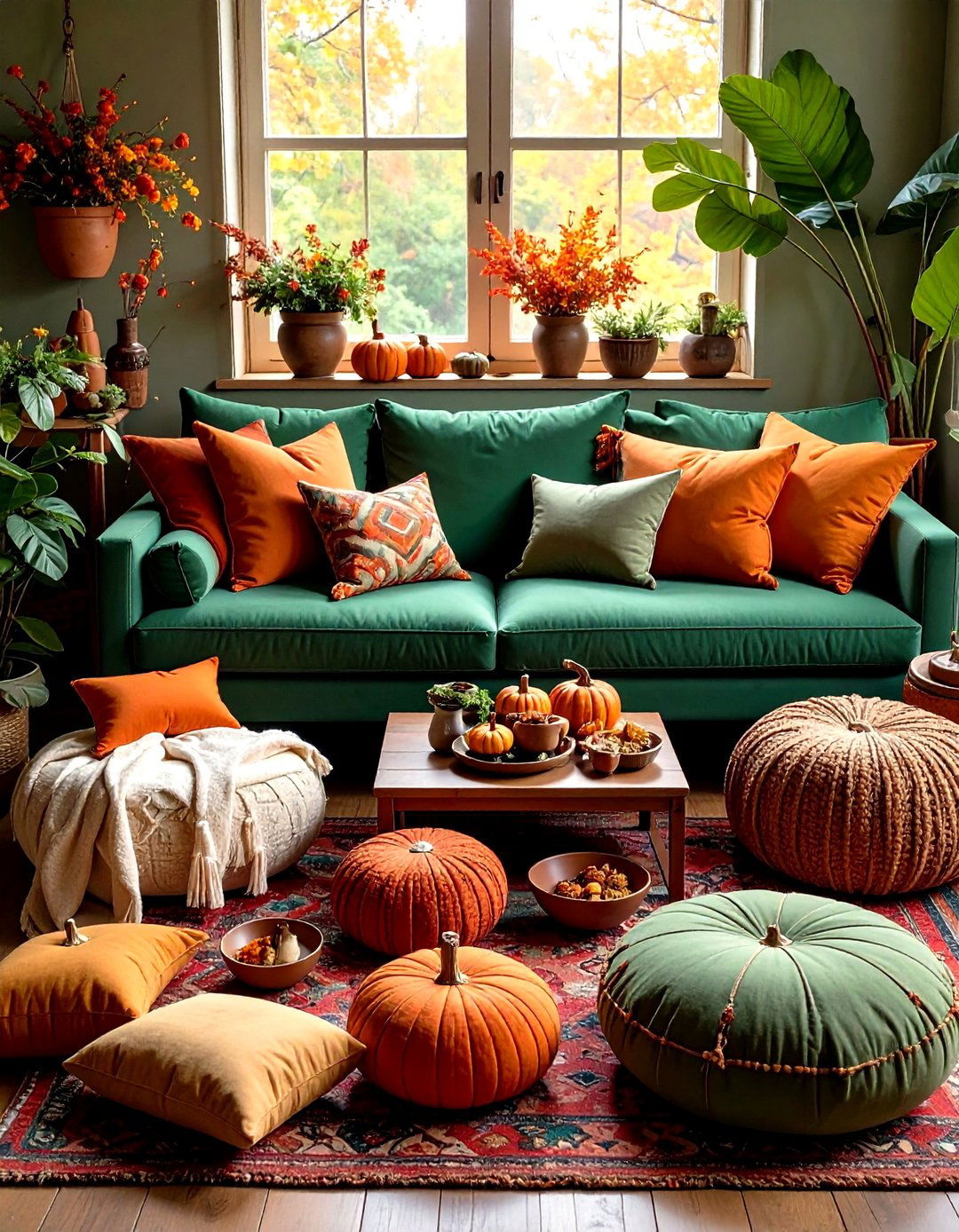
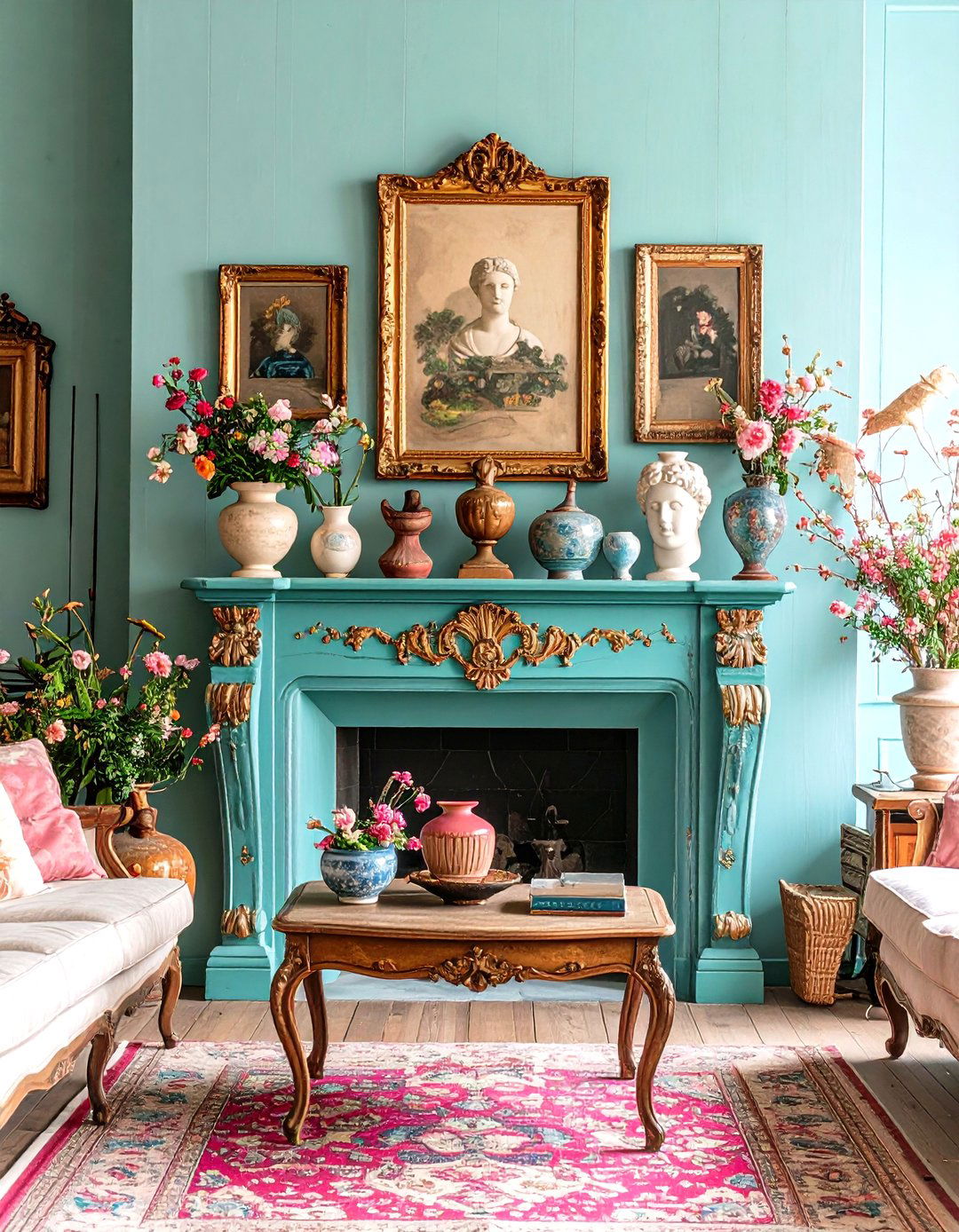
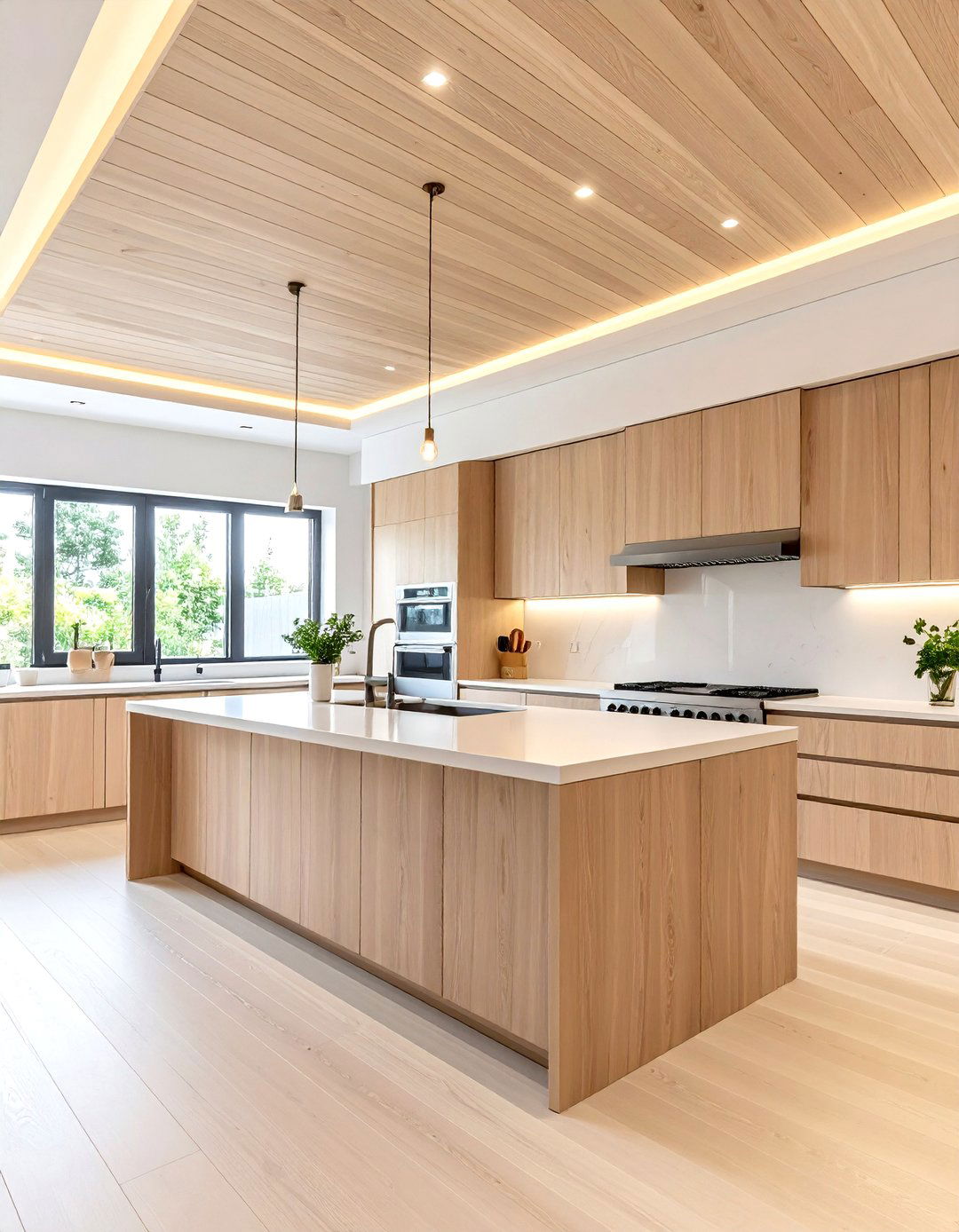
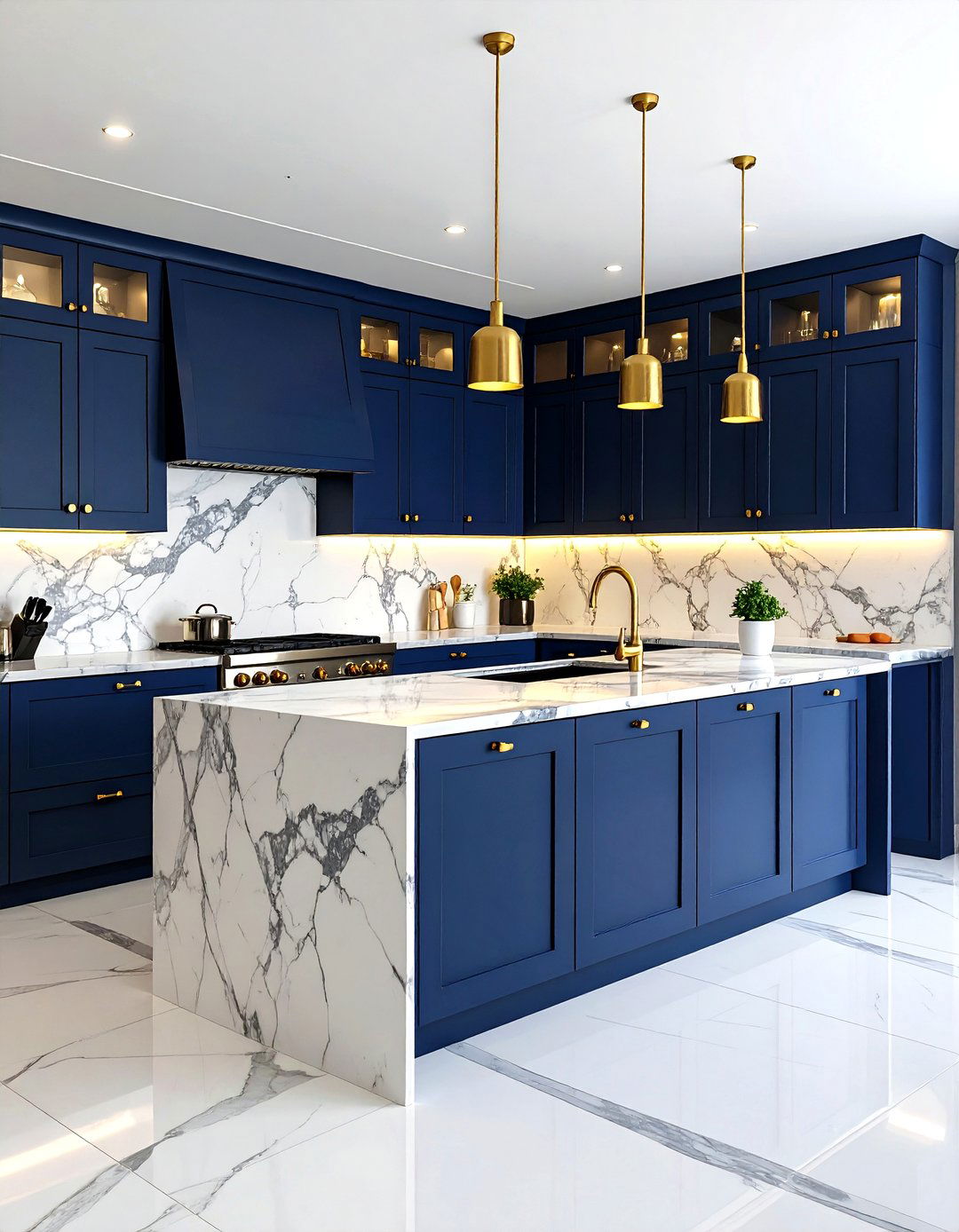
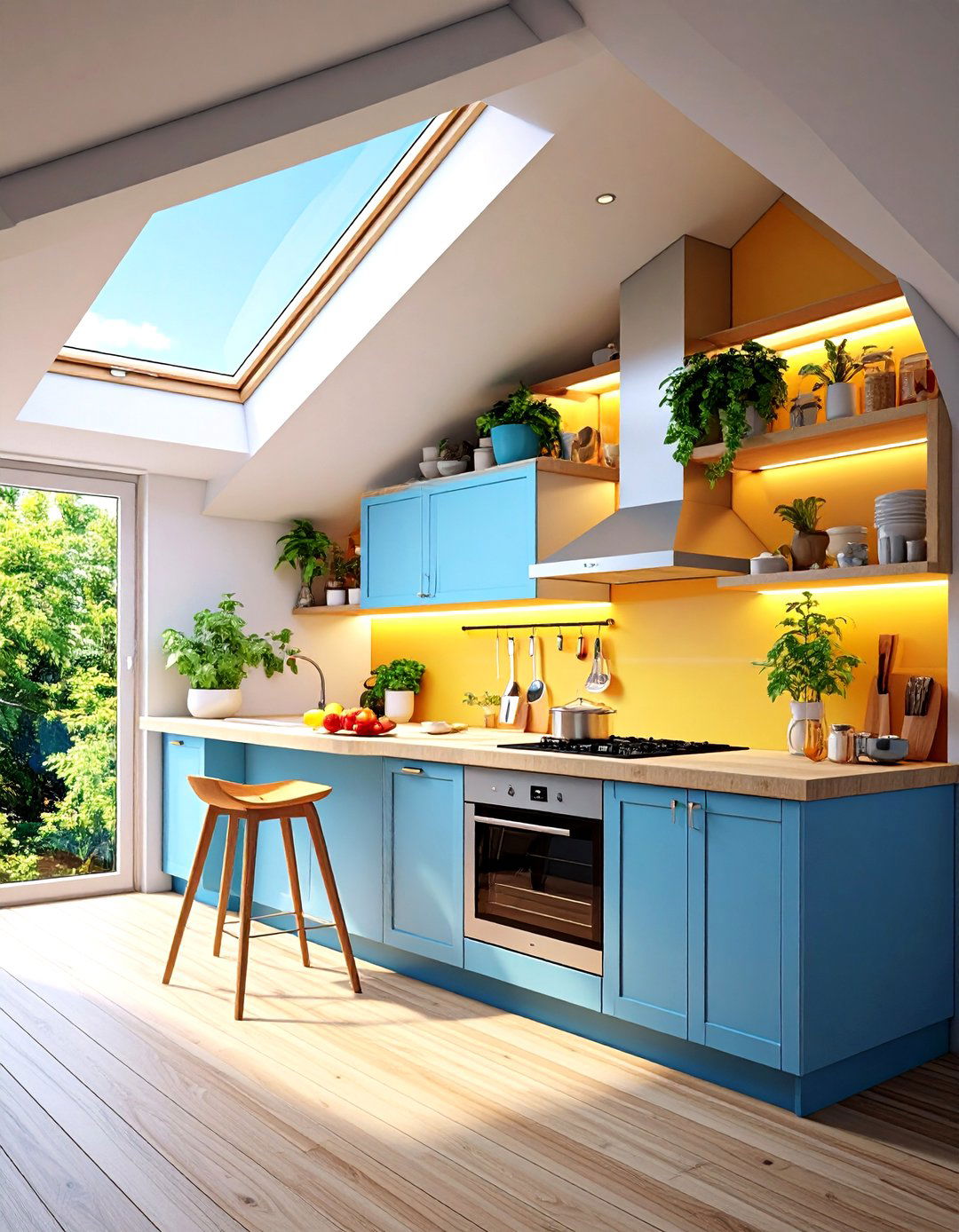
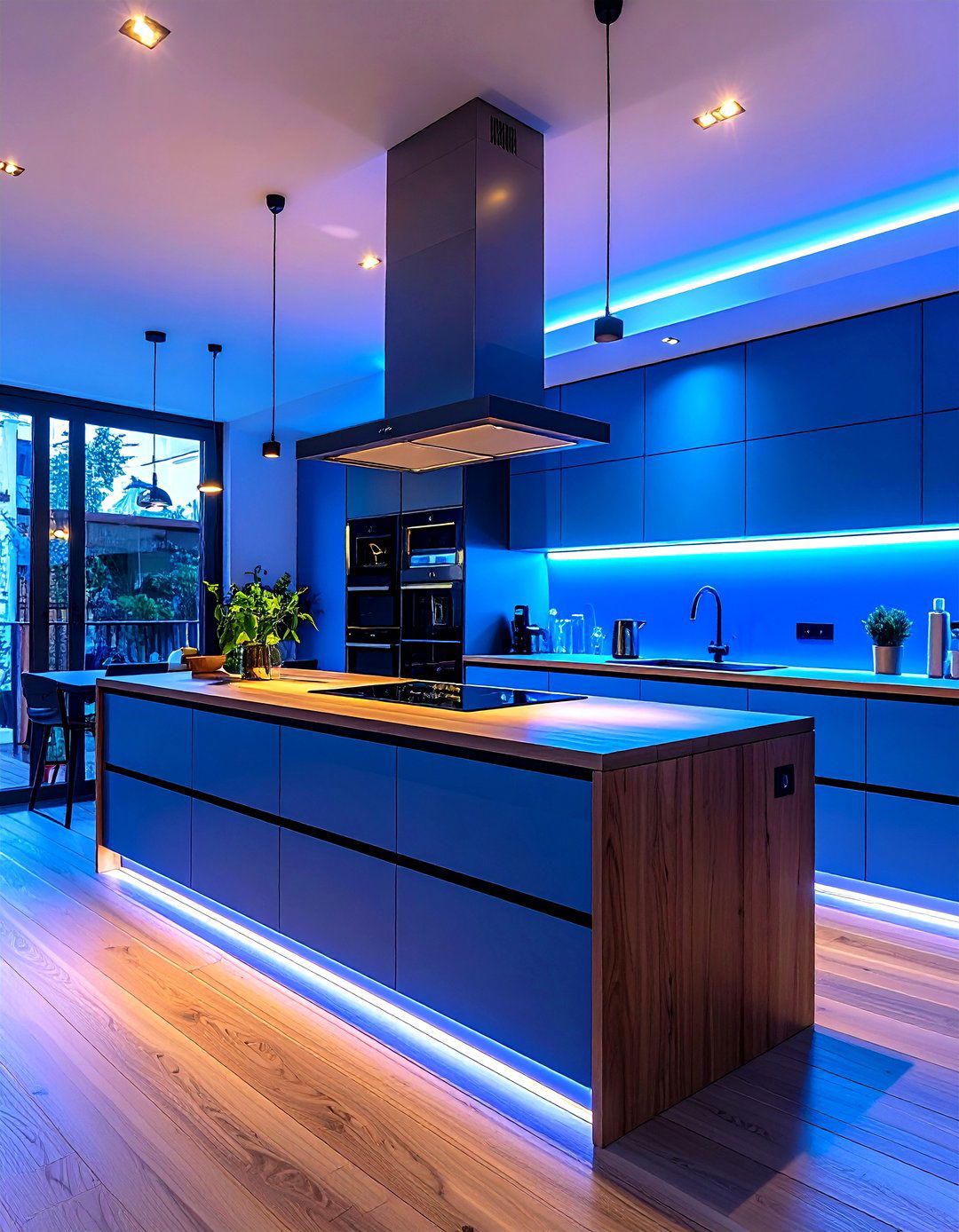
Leave a Reply